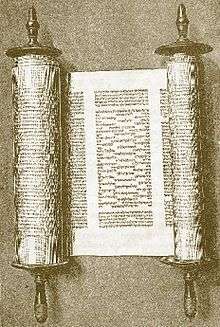Va'eira
Va'eira, Va'era, or Vaera (וָאֵרָא — Hebrew for "and I appeared," the first word that God speaks in the parashah, in Exodus 6:3) is the fourteenth weekly Torah portion (פָּרָשָׁה, parashah) in the annual Jewish cycle of Torah reading and the second in the Book of Exodus. It constitutes Exodus 6:2–9:35. The parashah tells of the first seven Plagues of Egypt.

It is made up of 6,701 Hebrew letters, 1,748 Hebrew words, 121 verses, and 222 lines in a Torah Scroll (סֵפֶר תּוֹרָה, Sefer Torah).[1] Jews read it the fourteenth Sabbath (שַׁבָּת, Shabbat) after Simchat Torah, generally in January, or rarely, in late December.[2]
Readings
In traditional Sabbath Torah reading, the parashah is divided into seven readings, or עליות, aliyot. In the Masoretic Text of the Hebrew Bible (תנ״ך, Tanakh), Parashat Va'eira has nine "open portion" (פתוחה, petuchah) divisions (roughly equivalent to paragraphs, often abbreviated with the Hebrew letter פ (peh)). Parashat Va'eira has seven further subdivisions, called "closed portion" (סתומה, setumah) divisions (abbreviated with the Hebrew letter ס (samekh)) within the open portion (פתוחה, petuchah) divisions. The first and second open portion (פתוחה, petuchah) divisions divide the first reading (עליה, aliyah). The third open portion (פתוחה, petuchah) covers the balance of the first and part of the second readings (עליות, aliyot). The fourth open portion (פתוחה, petuchah) covers the balance of the second reading (עליה, aliyah). The fifth open portion (פתוחה, petuchah) divides the fourth reading (עליה, aliyah). The sixth open portion (פתוחה, petuchah) covers the balance of the fourth, all of the fifth, and part of the sixth readings (עליות, aliyot). The seventh open portion (פתוחה, petuchah) separates part of the sixth reading (עליה, aliyah). The eighth open portion (פתוחה, petuchah) covers the balance of the sixth and part of the seventh readings (עליות, aliyot). And the ninth open portion (פתוחה, petuchah) covers the balance of the seventh reading (עליה, aliyah). Closed portion (סתומה, setumah) divisions separate the first and second readings (עליות, aliyot), separate the second and third readings (עליות, aliyot), and divide the fourth, fifth, and sixth readings (עליות, aliyot).[3]
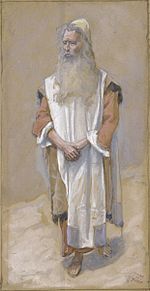
First reading — Exodus 6:2–13
In the first reading (עליה, aliyah), God spoke to Moses, identified God's Self as the God of the Patriarchs, and acknowledged hearing the moaning of the Israelites.[4] God instructed Moses to tell the Israelites that God would free them, make them God's people, and bring them to the Promised Land.[5] But the Israelites would not listen because of their distress and hard labor.[6] The first open portion (פתוחה, petuchah) ends here.[7]
In the continuation of the reading (עליה, aliyah), God told Moses to tell Pharaoh to let the Israelites go, but Moses complained that Pharaoh would not heed him, a man of impeded speech.[8] The second open portion (פתוחה, petuchah) ends here.[9]
In the continuation of the reading (עליה, aliyah), God commanded Moses and Aaron to bring the Israelites out of Egypt. The first reading (עליה, aliyah) and a closed portion (סתומה, setumah) end here.[10]
Second reading — Exodus 6:14–28
The second reading (עליה, aliyah) interjects a partial genealogy of Reuben, Simeon, and Levi, including Moses and his family.[11]
| Levi | |||||||||||||||||||||||||||||||||||||||||||
| Gershon | Kohath | Merari | Jochebed | ||||||||||||||||||||||||||||||||||||||||
| Amram | Izhar | Hebron | Uzziel | ||||||||||||||||||||||||||||||||||||||||
| Miriam | Aaron | Moses | |||||||||||||||||||||||||||||||||||||||||
The second reading (עליה, aliyah) and a closed portion (סתומה, setumah) end with the genealogy.[12]
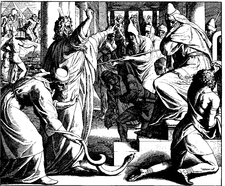
Third reading — Exodus 6:29–7:7
In the third reading (עליה, aliyah), God instructed Moses to tell Pharaoh all that God would tell Moses, but Moses protested that he had a speech impediment.[13] The third open portion (פתוחה, petuchah) ends here.[12]
In the continuation of the reading (עליה, aliyah), God placed Aaron in the role of Moses' prophet, to speak to Pharaoh.[14] God intended to harden Pharaoh's heart, so that God might show signs and marvels, so that the Egyptians would know that the Lord was God.[15] Moses and Aaron did as God commanded.[16] Moses was 80 years old, and Aaron 83 years old, when they spoke to Pharaoh.[17] The third reading (עליה, aliyah) and the fourth open portion (פתוחה, petuchah) end here.[18]
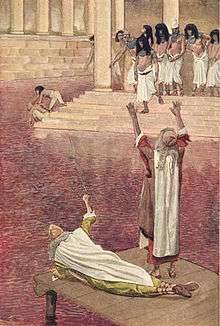
Fourth reading — Exodus 7:8–8:6
In the fourth reading (עליה, aliyah), God told how Aaron could cast down his rod and it would turn into a snake, and Aaron did so before Pharaoh.[19] Pharaoh caused his magicians to do the same, but Aaron's rod swallowed their rods.[20] Pharaoh's heart stiffened.[21] A closed portion (סתומה, setumah) ends here.[22]
In the continuation of the reading (עליה, aliyah), God began visiting ten plagues on Egypt. God told Moses to go to Pharaoh at his morning bath, demand of him to let the Israelites go to worship in the wilderness, and have Aaron strike the Nile with his rod and turn it into blood.[23] A closed portion (סתומה, setumah) ends here.[24]
In the continuation of the reading (עליה, aliyah), God told Moses to tell Aaron to stretch his rod over the waters of Egypt and turn them into blood.[25] Moses and Aaron did so, killing the fish and causing the Nile to stink.[26] But when the Egyptian magicians did the same, Pharaoh's heart stiffened.[27] Seven days passed.[28] The fifth open portion (פתוחה, petuchah) ends here.[29]
As the reading (עליה, aliyah) continues, God told Moses to have Aaron hold his arm with the rod over the river and bring up frogs, and they did so.[30] The magicians did the same.[31] Pharaoh summoned Moses and Aaron to plead with God to remove the frogs and said he would let the Israelites go[32] Moses asked Pharaoh when Moses should ask God, Pharaoh replied the next day, and Moses said that he would do so the next day, so that Pharaoh would know that there is none like God.[33] The fourth reading (עליה, aliyah) ends here.[34]
.jpg)
Fifth reading — Exodus 8:7–18
In the fifth reading (עליה, aliyah), the frogs departed, but Pharaoh became stubborn and did not let the Israelites leave.[35] A closed portion (סתומה, setumah) ends here.[36]
In the continuation of the reading (עליה, aliyah), God told Moses to have Aaron strike the dust with his rod, to turn it to lice throughout the land, and they did so.[37] The magicians tried to do the same, but they could not.[38] The magicians told Pharaoh, "This is the finger of God!" But Pharaoh's heart stiffened.[39] A closed portion (סתומה, setumah) ends here.[40]
In the continuation of the reading (עליה, aliyah), God told Moses to rise early and stand before Pharaoh as he came to the water and tell him that God said, "Let My people go," or else God would send swarms of flies on Egypt, but not on Goshen.[41] The fifth reading (עליה, aliyah) ends here.[42]

Sixth reading — Exodus 8:19–9:16
In the sixth reading (עליה, aliyah), God loosed swarms of insects against the Egyptians, but not Goshen, where the Israelites dwelt.[43] Pharaoh told Moses and Aaron to go sacrifice to God within Egypt, but Moses insisted on going three days into the wilderness.[44] Pharaoh agreed, in exchange for Moses' prayer to lift the plague.[45] But when God removed the insects, Pharaoh became stubborn again.[46] The sixth open portion (פתוחה, petuchah) ends here with the end of chapter 8.[47]
As the reading (עליה, aliyah) continues with chapter 9, God struck the Egyptian's livestock with a pestilence, sparing the Israelites' livestock.[48] But Pharaoh remained stubborn.[49] The seventh open portion (פתוחה, petuchah) ends here.[50]
In the continuation of the reading (עליה, aliyah), God told Moses to take handfuls of soot from the kiln and throw it toward the sky, so that it would become a fine dust, causing boils on man and beast throughout Egypt, and he did so.[51] But God stiffened Pharaoh's heart.[52] A closed portion (סתומה, setumah) ends here.[53]
In the continuation of the reading (עליה, aliyah), God told Moses to rise early and tell Pharaoh that God said, "Let My people go," or this time God would send all God's plagues upon Pharaoh and his people to demonstrate God's power.[54] The sixth reading (עליה, aliyah) ends here,[55]
.jpg)
Seventh reading — Exodus 9:17–35
In the seventh reading (עליה, aliyah), God instructed Moses to threaten hail such as Egypt had never seen, and to instruct the Egyptians to bring their cattle in from the field so that they would not die.[56] Those who feared God's word brought their slaves and livestock indoors, and those who did not fear God's word left them in the field.[57] The eighth open portion (פתוחה, petuchah) ends here.[58]
In the continuation of the reading (עליה, aliyah), God told Moses to stretch out his hand, and God sent thunder and hail, which struck down all exposed in Egypt, but did not strike Goshen.[59] Pharaoh confessed his wrong, agreed to let the Israelites go, and asked Moses and Aaron to pray to end the hail.[60] Moses told Pharaoh that he would do so, and the hail would end so that Pharaoh would know that the earth is God's, but Moses knew that Pharaoh and his servants would not yet fear God.[61] The hail had destroyed the flax and the barley, but not the wheat and the spelt, which ripened later.[62]
In the maftir (מפטיר) reading that concludes the parashah,[63] Moses spread forth his hands to God, and the thunders and hail ceased, but when Pharaoh saw, he hardened his heart and did not let the Israelites go.[64] The seventh reading (עליה, aliyah), the ninth open portion (פתוחה, petuchah), and the parashah end here with the end of chapter 9.[65]
Readings according to the triennial cycle
Jews who read the Torah according to the triennial cycle of Torah reading read the parashah according to the following schedule:[66]
| Year 1 | Year 2 | Year 3 | |
|---|---|---|---|
| 2016–2017, 2019–2020 ... | 2017–2018, 2020–2021 ... | 2018–2019, 2021–2022 ... | |
| Reading | 6:2–7:7 | 7:8–8:15 | 8:16–9:35 |
| 1 | 6:2–5 | 7:8–13 | 8:16–23 |
| 2 | 6:6–9 | 7:14–18 | 8:24–28 |
| 3 | 6:10–13 | 7:19–25 | 9:1–7 |
| 4 | 6:14–19 | 7:26–29 | 9:8–16 |
| 5 | 6:20–25 | 8:1–6 | 9:17–21 |
| 6 | 6:26–28 | 8:7–11 | 9:22–26 |
| 7 | 6:29–7:7 | 8:12–15 | 9:27–35 |
| Maftir | 7:5–7 | 8:12–15 | 9:33–35 |
In ancient parallels
The parashah has parallels in these ancient sources:
Exodus chapter 8
Reading the Egyptian magicians’ words in 8:15, “This is the finger of God!” the 20th century Reform Rabbi Gunther Plaut reported that in Egyptian literature, a plague is called “the hand of God,” while among Babylonians, the expression was the name of a sickness.[67]
In inner-biblical interpretation
The parashah has parallels or is discussed in these Biblical sources:[68]
.jpg)
Exodus chapter 6
In Exodus 2:24 and 6:5–6, God remembered God's covenant with Abraham, Isaac, and Jacob to deliver the Israelites from Egyptian bondage. Similarly, God remembered Noah to deliver him from the flood in Genesis 8:1; God promised to remember God's covenant not to destroy the Earth again by flood in Genesis 9:15–16; God remembered Abraham to deliver Lot from the destruction of Sodom and Gomorrah in Genesis 19:29; God remembered Rachel to deliver her from childlessness in Genesis 30:22; Moses called on God to remember God's covenant with Abraham, Isaac, and Jacob to deliver the Israelites from God's wrath after the incident of the Golden Calf in Exodus 32:13 and Deuteronomy 9:27; God promises to "remember" God's covenant with Jacob, Isaac, and Abraham to deliver the Israelites and the Land of Israel in Leviticus 26:42–45; the Israelites were to blow upon their trumpets to be remembered and delivered from their enemies in Numbers 10:9; Samson called on God to deliver him from the Philistines in Judges 16:28; Hannah prayed for God to remember her and deliver her from childlessness in 1 Samuel 1:11 and God remembered Hannah's prayer to deliver her from childlessness in 1 Samuel 1:19; Hezekiah called on God to remember Hezekiah's faithfulness to deliver him from sickness in 2 Kings 20:3 and Isaiah 38:3; Jeremiah called on God to remember God's covenant with the Israelites to not condemn them in Jeremiah 14:21; Jeremiah called on God to remember him and think of him, and avenge him of his persecutors in Jeremiah 15:15; God promises to remember God's covenant with the Israelites and establish an everlasting covenant in Ezekiel 16:60; God remembers the cry of the humble in Zion to avenge them in Psalm 9:13; David called upon God to remember God's compassion and mercy in Psalm 25:6; Asaph called on God to remember God's congregation to deliver them from their enemies in Psalm 74:2; God remembered that the Israelites were only human in Psalm 78:39; Ethan the Ezrahite called on God to remember how short Ethan's life was in Psalm 89:48; God remembers that humans are but dust in Psalm 103:14; God remembers God's covenant with Abraham, Isaac, and Jacob in Psalm 105:8–10; God remembers God's word to Abraham to deliver the Israelites to the Land of Israel in Psalm 105:42–44; the Psalmist calls on God to remember him to favor God's people, to think of him at God's salvation, that he might behold the prosperity of God's people in Psalm 106:4–5; God remembered God's covenant and repented according to God's mercy to deliver the Israelites in the wake of their rebellion and iniquity in Psalm 106:4–5; the Psalmist calls on God to remember God's word to God's servant to give him hope in Psalm 119:49; God remembered us in our low estate to deliver us from our adversaries in Psalm 136:23–24; Job called on God to remember him to deliver him from God's wrath in Job 14:13; Nehemiah prayed to God to remember God's promise to Moses to deliver the Israelites from exile in Nehemiah 1:8; and Nehemiah prayed to God to remember him to deliver him for good in Nehemiah 13:14–31.
Professor Nahum Sarna, formerly of Brandeis University, noted that the first two verbs in Exodus 6:7, “I will take you to Me for a people, and I will be to you a God,” are both used in connection with matrimony — “to take” (לקח, l-k-ch) in Genesis 4:19; 6:2; 11:29, and more than 70 other Biblical occurrences, and “to be (someone’s)” (היה ל, h-y-h le-) in Leviticus 21:3; Numbers 30:7; Deuteronomy 24:4; Judges 14:20; 15:2; 2 Samuel 12:10; Jeremiah 3:1; Ezekiel 16:8; and Hosea 3:3.[69] Jeffrey Tigay, Professor Emeritus at the University of Pennsylvania, and Professor Bruce Wells of Saint Joseph’s University noted that the Hebrew Bible also uses similar language for adoption, for example in 2 Samuel 7:14 (“I will be to him”), and thus one can say that God adopted the Israelites.[70]
Exodus chapters 7–12
The description of the 10 plagues exhibits patterns and progressions, as follows:
| Cycle | Number | Plague | Verses | Was There
Warning? |
Time Warned | Introduction | Actor | Rod? | Israelites
Shielded? |
Did Pharaoh
Concede? |
Who Hardened
Pharaoh's Heart? |
|---|---|---|---|---|---|---|---|---|---|---|---|
| First | 1 | blood | Exodus 7:14–25 | yes | in the morning | לֵךְ אֶל-פַּרְעֹה
Go to Pharaoh |
Aaron | yes | no | no | passive voice |
| 2 | frogs | Exodus 7:26–8:11 | yes | unknown | בֹּא אֶל-פַּרְעֹה
Go in to Pharaoh |
Aaron | yes | no | yes | passive voice | |
| 3 | gnats or lice | Exodus 8:12–15
(8:16–19 in the KJV) |
no | none | none | Aaron | yes | no | no | passive voice | |
| Second | 4 | flies or
wild beasts |
Exodus 8:16–28
(8:20–32 in the KJV) |
yes | early in the morning | וְהִתְיַצֵּב לִפְנֵי פַרְעֹה
stand before Pharaoh |
God | no | yes | yes | Pharaoh |
| 5 | livestock | Exodus 9:1–7 | yes | unknown | בֹּא אֶל-פַּרְעֹה
Go in to Pharaoh |
God | no | yes | no | Pharaoh | |
| 6 | boils | Exodus 9:8–12 | no | none | none | Moses | no | no | no | God | |
| Third | 7 | hail | Exodus 9:13–35 | yes | early in the morning | וְהִתְיַצֵּב לִפְנֵי פַרְעֹה
stand before Pharaoh |
Moses | no | yes | yes | passive voice |
| 8 | locusts | Exodus 10:1–20 | yes | unknown | בֹּא אֶל-פַּרְעֹה
Go in to Pharaoh |
Moses | yes | no | yes | God | |
| 9 | darkness | Exodus 10:21–29 | no | none | none | Moses | yes | yes | yes | God | |
| 10 | firstborn | Exodus 11:1–10; | yes | unknown | none | God | no | yes | yes | God |
Psalm 78:44–51 and 105:23–38 each recount differing arrangements of seven plagues. Psalm 78:44–51 recalls plagues of (1) blood, (2) flies, (3) frogs, (4) locusts, (5) hail, (6) livestock, and (7) firstborn, but not plagues of lice, boils, or darkness. Psalm 105:23–38 recalls plagues of (1) darkness, (2) blood, (3) frogs, (4) flies and lice, (5) hail, (6) locusts, and (7) firstborn, but not plagues of livestock or boils.
In early nonrabbinic interpretation
The parashah has parallels or is discussed in these early nonrabbinic sources:[71]
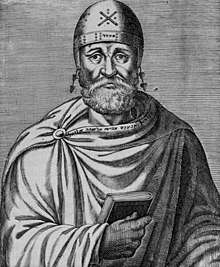
Exodus chapter 6
Philo read the words of Exodus 6:3, "I did not make Myself known to them by My name," to teach that no proper name can properly be assigned to God. Philo noted that God told Moses in Exodus 3:14, "I Am that I Am," which Philo equated with, "It is my nature to be, not to be described by name." But in order that human beings not be wholly without anything to call God, God allowed us to use the Name "Lord." God addressed this Name to mortal humans who have need of the Divine Name so that, if they cannot attain to the best thing, they may at least know the best possible Name. Philo noted that in Exodus 6:3, God speaks of the proper name of God never having been revealed to anyone. Philo suggested that God's statement in Exodus 6:3 meant that God had not revealed to them God's proper Name, but only that which could commonly be used. For Philo argued that God is so completely indescribable, that even those powers that minister to God do not announce God's proper Name to us. And thus after Jacob's wrestling match at the Jabok, Jacob asked the invisible Master for a name, but Jacob's Opponent did not tell him a proper name, saying that it was sufficient for Jacob to be taught ordinary explanations. But as for names that are the true symbols of things, we are taught not to seek them for the Immortal.[72]
In classical rabbinic interpretation
The parashah is discussed in these rabbinic sources from the era of the Mishnah and the Talmud:[73]
.jpg)
Exodus chapter 6
A Midrash noted that God had already informed Moses that Pharaoh would not allow the Israelites to go, as in Exodus 3:19, God told Moses, "I know that the King of Egypt will not allow you to go," and in Exodus 4:19, God told Moses, "I will harden his heart." But Moses did not keep this in mind, but came instead to doubt the wisdom of God's decree, and began to argue with God, saying in Exodus 5:22: "Lord, why have You dealt ill with this people?" For this reason, the Attribute of Justice sought to attack Moses, as Exodus 6:2 says: "And God spoke to Moses" (employing the name of God (אֱלֹהִים, Elohim) indicative of God's Justice). But when God reflected that Moses only asked this because of Israel's suffering, God retracted and dealt with Moses according to the Attribute of Mercy, as Exodus 6:2 says: "And He said to him: ‘I am the Lord'" (employing the name of God (יְהוָה, the Tetragrammaton) indicative of God's Mercy). The Midrash viewed the question of Moses in Exodus 5:22 as an application of Ecclesiastes 2:12: "And I turned myself to behold wisdom, and madness and folly; for what can the man do who comes after the King? even that which has been already done." The Midrash taught that Ecclesiastes 2:12 refers to both Solomon and Moses. The Midrash taught that Ecclesiastes 2:12 refers to Solomon, for God gave some commandments for kings, as it says in Deuteronomy 17:16–17: "Only he shall not multiply horses to himself . . . Neither shall he multiply wives to himself, that his heart turn not away; neither silver and gold." Solomon read in Deuteronomy 17:17 that the reason of God's decree was "that his heart turn not away." The Midrash taught that Solomon thus thought to himself that he would multiply his wives but still not allow his heart to turn away. And the Midrash taught that Ecclesiastes 2:12 refers to Moses because Moses began to argue with God in Exodus 5:22, "Lord, why have you dealt ill with this people?" On account of this, the Midrash taught that at that point the wisdom and knowledge of Moses was only (in the words of Ecclesiastes 2:12) "madness and folly." The Midrash asked what right Moses had to question God's ways and in the words of Ecclesiastes 2:12, "that which had been already done" that God had revealed to him.[74]
.jpg)
Reading the words, "And I appeared to Abraham, to Isaac, and to Jacob," in Exodus 6:3, a Midrash taught that God thus told Moses that God longed for those who were gone and could not be replaced — the three Patriarchs. The Midrash said that God told Moses that many times, God had revealed God's Self to Abraham, Isaac, and Jacob as God Almighty (אֵל שַׁדָּי, El Shadai),[75] and God had not made known to them that God's name is the Lord (יְהוָה, the Tetragrammaton). But still they did not criticize God's ways. To Abraham, God said in Genesis 13:17, "Arise, walk through the land in the length of it and in the breadth of it, for to you will I give it," yet when Abraham wanted to bury Sarah, he found no plot of ground until he had purchased one; still, he did not murmur at God's ways. God said to Isaac in Genesis 26:3, "Sojourn in this land . . . for to you, and to your seed, I will give all these lands." Yet when Isaac sought water to drink, he found none; instead (as Genesis 26:20 reports), "The herdsmen of Gerar strove with Isaac's herdsmen, saying: ‘The water is ours.'" Still Isaac did not murmur at God's ways. God said to Jacob in Genesis 28:13, "The land on which you lie, to you will I give it, and to your seed." Yet when he sought a place to pitch his tent, he found none until he purchased one for a hundred kesitah (as reported in Genesis 33:19). And still Jacob did not complain at God's ways. The Patriarchs did not ask God, as Moses did in Exodus 3:13, what God's name was. In contrast, at the commencement of God's commission of Moses, Moses inquired of God's name. And in Exodus 5:23, Moses told God, "For since I came to Pharaoh . . . he has dealt ill with this people; neither have You delivered Your people." On this account, the Midrash taught, God said in Exodus 6:4, "And I have also established my covenant with them," the Patriarchs, to give them the land, and they never complained of God's ways. And God said in Exodus 6:5, "I have heard the groaning of the children of Israel," because they did not complain against God. Although the Israelites of that generation did not conduct themselves righteously, yet God heard their cry on account of the covenant that God had made with the Patriarchs. Hence, it says in Exodus 6:6, "And I have remembered My covenant. Therefore, say to the children of Israel." The Midrash taught that the word "therefore" (לָכֵן, lachein) in Exodus 6:6 implies an oath, as it does in 1 Samuel 3:14, where God says, "And therefore I have sworn to the house of Eli." Thus, the Midrash taught that God swore to Moses that God would redeem the Israelites, so that Moses would have no reason to fear that the Attribute of Justice would retard their redemption.[76]
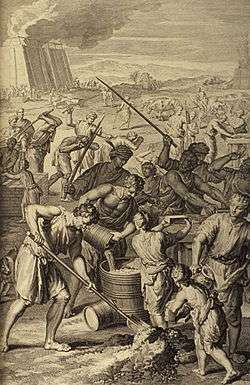
Rabbi Simai found evidence for the resurrection of the dead in the words, "And I also have established my covenant with them (the Patriarchs) to give them the land of Canaan," in Exodus 6:4. Rabbi Simai noted that Exodus 6:4 does not say "to give you" but "to give them," implying that God would give the land to the Patriarchs personally, and thus that God would resurrect them so as to fulfill the promise.[77]
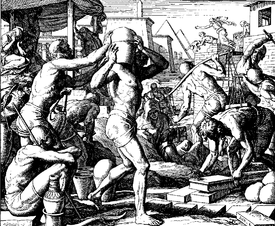
A Baraita deduced from Exodus 6:6 that the Israelites' bondage in Egypt ended on Rosh Hashanah. The Baraita noted that Exodus 6:6 uses the word "burden" to describe the end of the Israelites' bondage in Egypt, and Psalm 81:7 uses the word "burden" to describe the end of Joseph's imprisonment, and the Baraita deduced that the two events must therefore have occurred at the same time of year. The Baraita further deduced from the words, "Blow the horn on the new moon, on the covering day for our festival . . . He appointed it for Joseph for a testimony when he went forth," in Psalm 81:4–6 that Joseph went forth from the prison on Rosh Hashanah.[78]
Rabbi Nehemiah cited the use of the words "will bring you out" in Exodus 6:6 to demonstrate that using the word hamotzi in the blessing over bread would mean that God "will bring forth" bread from the land — not that God "has brought forth" bread from the land. Rabbi Nehemiah thus read Exodus 6:6–7 to mean: "I am the Lord, the One Who will bring you out from under the burdens of the Egyptians." The Gemara reported that the Rabbis of a Baraita, however, read Exodus 6:6–7 to mean: "When I shall bring you out, I will do for you something that will show you that I am the One Who brought you out from under the burdens of the Egyptians."[79]
The Jerusalem Talmud cited the four promises of salvation in Exodus 6:6–7, (1) "I will bring you out from under the burdens of the Egyptians," (2) "I will deliver you from their bondage," (3) "I will redeem you with an outstretched arm," and (4) "I will take you to Me for a people," as one reason why Jews drink four cups of wine at the Passover seder.[80] And thus the Mishnah taught that "On the eve of Passover, . . . even the poorest man in Israel must not eat until he reclines; and they (the overseers of charity) should give him not less than four cups of wine."[81]
A Baraita taught that Rabbi Simai deduced from the similarity of the phrases "And I will take you to me for a people" and "And I will bring you in to the land" in Exodus 6:7 that the Israelites' Exodus from Egypt occurred under circumstances similar to their entry into the Land of Israel. Rabbi Simai thus deduced that just as only two out of 600,000 (Caleb and Joshua) entered the Promised Land, so only two out of every 600,000 Israelites in Egypt participated in the Exodus, and the rest died in Egypt. Rava taught that it will also be so when the Messiah comes that only a small portion of Jews will find redemption, for Hosea 2:17 says, "And she shall sing there, as in the days of her youth, and as in the days when she came up out of the land of Egypt," implying that circumstances upon the coming of the Messiah will be similar to those upon the Israelites' entry into the Land of Israel.[82]
The Gemara asked why the Tannaim felt that the allocation of the Land of Israel "according to the names of the tribes of their fathers" in Numbers 26:55 meant that the allocation was with reference to those who left Egypt; perhaps, the Gemara supposed, it might have meant the 12 tribes and that the Land was to be divided into 12 equal portions? The Gemara noted that in Exodus 6:8, God told Moses to tell the Israelites who were about to leave Egypt, "And I will give it you for a heritage; I am the Lord," and that meant that the Land was the inheritance from the fathers of those who left Egypt.[83]
.jpg)
A Midrash interpreted the words of Exodus 6:9, "they hearkened not to Moses for shortness of spirit," to indicated that it was difficult for the Israelites to abandon idol worship.[84]
Rabbi Ishmael cited Exodus 6:12 as one of ten a fortiori (kal va-chomer) arguments recorded in the Hebrew Bible: (1) In Genesis 44:8, Joseph's brothers told Joseph, "Behold, the money that we found in our sacks' mouths we brought back to you," and they thus reasoned, "how then should we steal?" (2) In Exodus 6:12, Moses told God, "Behold, the children of Israel have not hearkened to me," and reasoned that surely all the more, "How then shall Pharaoh hear me?" (3) In Deuteronomy 31:27, Moses said to the Israelites, "Behold, while I am yet alive with you this day, you have been rebellious against the Lord," and reasoned that it would follow, "And how much more after my death?" (4) In Numbers 12:14, "the Lord said to Moses: ‘If her (Miriam's) father had but spit in her face,'" surely it would stand to reason, "‘Should she not hide in shame seven days?'" (5) In Jeremiah 12:5, the prophet asked, "If you have run with the footmen, and they have wearied you," is it not logical to conclude, "Then how can you contend with horses?" (6) In 1 Samuel 23:3, David's men said to him, "Behold, we are afraid here in Judah," and thus surely it stands to reason, "How much more then if we go to Keilah?" (7) Also in Jeremiah 12:5, the prophet asked, "And if in a land of Peace where you are secure" you are overcome, is it not logical to ask, "How will you do in the thickets of the Jordan?" (8) Proverbs 11:31 reasoned, "Behold, the righteous shall be requited in the earth," and does it not follow, "How much more the wicked and the sinner?" (9) In Esther 9:12, "The king said to Esther the queen: ‘The Jews have slain and destroyed 500 men in Shushan the castle,'" and it thus stands to reason, "‘What then have they done in the rest of the king's provinces?'" (10) In Ezekiel 15:5, God came to the prophet saying, "Behold, when it was whole, it was usable for no work," and thus surely it is logical to argue, "How much less, when the fire has devoured it, and it is singed?"[85]
Rav Zeira counted five kinds of orlah (things uncircumcised) in the world: (1) uncircumcised ears (as in Jeremiah 6:10), (2) uncircumcised lips (as in Exodus 6:12), (3) uncircumcised hearts (as in Deuteronomy 10:16 and Jeremiah 9:26), (4) uncircumcised flesh (as in Genesis 17:14), and (5) uncircumcised trees (as in Leviticus 19:23). Rav Zeira taught that all the nations are uncircumcised in each of the first four ways, and all the house of Israel are uncircumcised in heart, in that their hearts do not allow them to do God's will. And Rav Zeira taught that in the future, God will take away from Israel the uncircumcision of their hearts, and they will not harden their stubborn hearts anymore before their Creator, as Ezekiel 36:26 says, "And I will take away the stony heart out of your flesh, and I will give you an heart of flesh," and Genesis 17:11 says, "And you shall be circumcised in the flesh of your foreskin."[86]
.jpg)
Reading Exodus 6:13, 7:8, and 9:8, a Midrash taught that in 18 verses, Scripture places Moses and Aaron (the instruments of Israel's deliverance) on an equal footing (reporting that God spoke to both of them alike),[87] and thus there are 18 benedictions in the Amidah.[88]
Reading the words of Exodus 6:13, "And the Lord spoke to Moses and to Aaron, and gave them a command concerning the children of Israel," Rabbi Samuel bar Rabbi Isaac asked about what matter God commanded the Israelites. Rabbi Samuel bar Rabbi Isaac taught that God gave them the commandment about the freeing of slaves in Exodus 21:2–11.[89]
.jpg)
A Midrash interpreted the words of Exodus 6:13, "And He gave them a charge concerning the children of Israel," to convey that God warned Moses and Aaron that the Israelites were obstinate, bad-tempered, and troublesome, and that in assuming leadership over the Israelites, Moses and Aaron must expect that the Israelites would curse and even stone them.[90]
A Midrash interpreted God's instructions to Moses and Aaron in Exodus 6:13, "and to Pharaoh, King of Egypt," to convey that God told Moses and Aaron that although God really ought to punish Pharaoh, God wanted Moses and Aaron to show Pharaoh the respect due to his regal position. And Moses did so, as Exodus 11:8 reports that Moses told Pharaoh that God said, "And all these your servants shall come down to Me." Moses did not say that Pharaoh would come down, only that Pharaoh's servants would do so. But Moses could well have said that Pharaoh himself would come down, for Exodus 12:30 reports, "Pharaoh arose at midnight." But Moses did not mention Pharaoh specifically so as to pay him respect.[90]
| Levi | |||||||||||||||||||||||||||||||||||||||||||||||||||||||||||||||||||||||||||
| Kohath | |||||||||||||||||||||||||||||||||||||||||||||||||||||||||||||||||||||||||||
| Amram | Izhar | Hebron | Uzziel | ||||||||||||||||||||||||||||||||||||||||||||||||||||||||||||||||||||||||
| Miriam | Aaron | Moses | Korah | Nepheg | Zichri | Mishael | Elzaphan | Sithri | |||||||||||||||||||||||||||||||||||||||||||||||||||||||||||||||||||
A Midrash taught that Korah took issue with Moses in Numbers 16:1 because Moses had (as Numbers 3:30 reports) appointed Elizaphan the son of Uzziel as prince of the Kohathites, and Korah was (as Exodus 6:21 reports) son of Uzziel's older brother Izhar, and thus had a claim to leadership prior to Elizaphan.[91]
Rava taught that he who wishes to take a wife should first inquire about the character of her brothers. For Exodus 6:23 reports, "And Aaron took Elisheva, the daughter of Amminadab, the sister of Nahshon." As Exodus 6:23 states "the daughter of Amminadab," it is obvious that she was the sister of Nahshon. So Exodus 6:23 expressly states "the sister of Nahshon" to imply that he who takes a wife should inquire about the character of her brothers, because most children resemble the brothers of their mother.[92]
The Gemara asked whether the words in Exodus 6:25, "And Eleazar Aaron's son took him one of the daughters of Putiel to wife" did not convey that Eleazar's son Phinehas descended from Jethro, who fattened (piteim) calves for idol worship. The Gemara then provided an alternative explanation: Exodus 6:25 could mean that Phinehas descended from Joseph, who conquered (pitpeit) his passions (resisting Potiphar's wife, as reported in Genesis 39).[93] But the Gemara asked, did not the tribes sneer at Phinehas and question how a youth (Phinehas) whose mother's father crammed calves for idol-worship could kill the head of a tribe in Israel (Zimri, Prince of Simeon, as reported in Numbers 25). The Gemara explained that the real explanation was that Phinehas descended from both Joseph and Jethro. If Phinehas's mother's father descended from Joseph, then Phinehas's mother's mother descended from Jethro. And if Phinehas's mother's father descended from Jethro, then Phinehas's mother's mother descended from Joseph. The Gemara explained that Exodus 6:25 implies this dual explanation of "Putiel" when it says, "of the daughters of Putiel," because the plural "daughters" implies two lines of ancestry (from both Joseph and Jethro).[94]
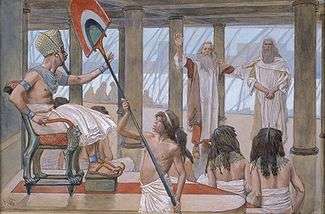
Rabbi Simeon noted that in nearly every instance, the Torah mentioned Moses before Aaron, but Exodus 6:26 mentioned Aaron before Moses, teaching that the two were deemed equivalent.[95] The Gemara taught that the use of the pronoun "he (hu)" in an introduction, as in the words "These are (hu) that Aaron and Moses" in Exodus 6:26 signifies that they were the same in their righteousness from the beginning to the end. Similar uses appear in Chronicles 1:27 to teach Abraham's enduring righteousness, in 1 Samuel 17:14 to teach David's enduring humility, in Genesis 36:43 to teach Esau's enduring wickedness, in Numbers 26:9 to teach Dathan and Abiram's enduring wickedness, in 2 Chronicles 28:22 to teach Ahaz's enduring wickedness, and in Esther 1:1 to teach Ahasuerus's enduring wickedness.[96]
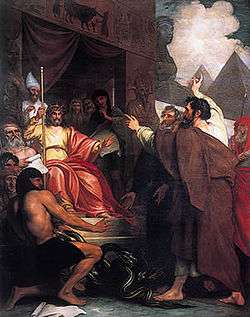
Exodus chapter 7
The Tosefta cited Exodus 7:1, where the lesser Aaron spoke for the greater Moses, for the proposition that in synagogue reading, a minor may translate for an adult, but it is not honorable for an adult to translate for a minor.[97]
Rabbi Phinehas, the priest, son of Rabbi Hama, interpreted God's hardening of Pharaoh's heart (for example in Exodus 7:3) in light of Job 36:13, "But they who are godless in heart lay up anger; they cry not for help when He binds them." Rabbi Phinehas taught that if the godless, for whose repentance God waits, do not do so, then later on, even when they do think of it, God distracts their hearts from penitence. Rabbi Phinehas interpreted the words of Job 36:13, "And they who are godless in heart," to teach that those who begin by being godless in heart end up bringing upon themselves God's anger. And Rabbi Phinehas interpreted the words of Job 36:13, "They cry not for help when He binds them," to teach that though the godless wish later to return to God and to pray to God, they are no longer able, because God binds them and bars their way. Thus after several plagues, Pharaoh wished to pray to God, but God told Moses in Exodus 8:16: "Before he goes out [to pray to God], stand before Pharaoh."[98]
The Pirke De-Rabbi Eliezer told that Moses quoted God's words in Exodus 7:4 back to God after the sin of the Golden Calf. The Pirke De-Rabbi Eliezer told that after the incident of the Golden Calf, God told Moses that the Israelites had forgotten God's might and had made an idol. Moses replied to God that while the Israelites had not yet sinned, God had called them "My people," as in Exodus 7:4, God had said, "And I will bring forth My hosts, My people." But Moses noted that once the Israelites had sinned, God told Moses (in Exodus 32:7), "Go, get down, for your people have corrupted themselves." Moses told God that the Israelites were indeed God's people, and God's inheritance, as Deuteronomy 9:29 reports Moses saying, "Yet they are Your people and Your inheritance."[99]
A Midrash read Exodus 7:11, “Then Pharaoh also called for the wise men and the sorcerers,” to teach that Scripture calls nonbelievers “wise men” when they do something that requires skill.[100]
Rabbi Aivu bar Nagri said in the name of Rabbi Hiyya bar Abba that the words "with their enchantments" in Exodus 7:11 refer to sorcery without exogenous assistance, while the words "with their sorcery" in Exodus 7:22 refer to magic through the agency of demons.[101]
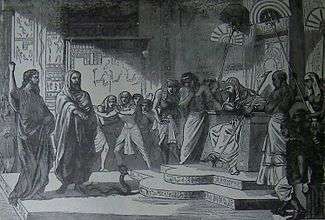
Reading the words, "Aaron's rod swallowed up their rods," in Exodus 7:12, Rabbi Eleazar observed that it was a double miracle (as Aaron's serpent first became a rod again, and as a rod it swallowed up their serpents).[102] When Pharaoh saw this, he was amazed and expressed his fear of what would happen if Moses now told the rod to swallow up Pharaoh and his throne. Rabbi Jose bar Hanina taught that a great miracle happened to that rod, for although it swallowed up all the rods that had been cast down, sufficient to make ten heaps, still the rod did not all become any thicker, and all who saw it recognized it as Aaron's rod. On this account, Aaron's rod became a symbol for all the miracles and wonders that were to be performed for Israel throughout the generations.[103]
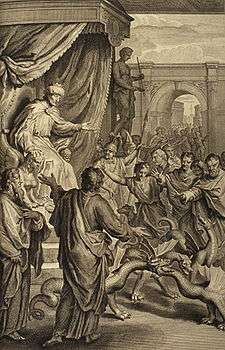
A Midrash noted that Exodus 7:13 reports that "Pharaoh's heart was hardened" without God's action, and that this was so for the first five plagues. As the first five plagues did not move Pharaoh to release the Israelites, God decreed that from then on, even if Pharaoh had agreed to release the Israelites, God would not accept it. Thus starting with the sixth plague and thereafter (as Exodus 10:27 reports), the text says, "the Lord hardened Pharaoh's heart."[104]
It was taught in a Baraita that Rabbi Judah the Prince (or others say Rabbi Meir) used to say that Providence repays a person measure for measure.[105] Thus, a Midrash taught that God sent the plagues against Pharaoh measure for measure. God changed the Egyptians' water into blood because the Egyptians prevented the Israelites from using the ritual bath (מִקְוֶה, mikveh) so as to prevent the Israelite women from having marital relations with their husbands. God brought frogs because the Egyptians had ordered the Israelites to bring them reptiles and creeping creatures (which were an abomination to the Israelites). God sent lice because the Egyptians had made the Israelites clean the dirty streets and marketplaces. God sent swarms of wild animals because the Egyptians had demanded that the Israelites catch bears, lions, and leopards so as to separate the Israelite men from their wives. God brought the pestilence upon the Egyptians' cattle because they had forced the Israelites to serve as shepherds so as to keep the Israelite men away from their wives. God sent boils because the Egyptians had demanded that the Israelites warm things for them. God sent hail to destroy the Egyptians' crops because the Egyptians had sent the Israelites into the fields to plow and sow. God brought the locusts to destroy the Egyptians' grain because the Egyptians had forced the Israelites to plant wheat and barley for them. God brought darkness because among the Israelites were transgressors who had Egyptian patrons and lived in affluence and honor in Egypt and did not want to leave Egypt, and so God brought darkness so that God could kill these transgressors without the Egyptians' seeing.[106]
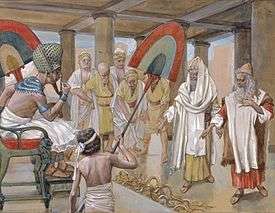
Abitol the barber, citing Rav, said that the Pharaoh whom Moses addressed was a puny fellow, a cubit tall, with a beard as long as he was tall, embodying the words in Daniel 4:14 that "the Most High rules in the kingdom of men, and . . . sets up over it the lowest of men." And Abitol the barber, citing Rav, deduced from the words "Pharaoh . . . goes out to the water" in Exodus 7:15 that this Pharaoh was a magus who went to the water to perform sorcery.[107]
Alternatively, a Midrash, reading the words "Pharaoh . . . goes out to the water" in Exodus 7:15, taught that only in the morning did Pharaoh go out to the water, because Pharaoh used to boast that he was a god and did not need to relieve himself. Therefore, Pharaoh used to go early in the morning to the water (when no one else was there to witness that he relieved himself like other humans). God, therefore, told Moses to catch him just at this critical moment.[108]
.jpg)
A Midrash cited Exodus 7:20 as one proof for the proposition that God does all things together: God puts to death and brings to life at the same time; God wounds and heals at the same time. And thus the Midrash noted, in Exodus 7:20, "all the waters that were in the river were turned to blood," and later, the blood became water again.[109]
Rabbi Abin the Levite, the son of Rabbi Judah the Prince, taught that the Israelites became wealthy from the plague of blood. If an Egyptian and an Israelite were in a house where there was a barrel full of water, and the Egyptian went to fill a pitcher from the barrel, the Egyptian would find that it contained blood, while the Israelite would drink water from the same barrel. When the Egyptian asked the Israelite to give the Egyptian some water with the Israelite's own hand, it still became blood. Even if the Egyptian said to the Israelite that they should both drink from one vessel, the Israelite would drink water, but the Egyptian would drink blood. It was only when the Egyptian bought water from the Israelite for money that the Egyptian was able to drink water. And this is how the Israelites became rich.[110]
The Gemara deduced from the use of the word for fish, dagah, in the phrase "And the fish that were in the river died" in Exodus 7:21 that the word dagah applies to fish both large and small.[111]
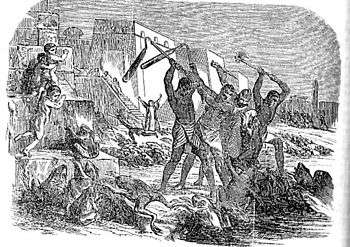
A Midrash taught that the frogs were the most grievous of the ten plagues. The Midrash taught that the frogs destroyed the Egyptians' bodies, as Psalm 78:45 says "frogs . . . destroyed them," and the frogs emasculated the Egyptians, as Exodus 7:28 says that the frogs would "come into . . . [the Egyptians'] bed-chamber, and upon [their] bed." The Midrash taught that the frogs told the Egyptians that the coinage of their gods was abolished, and the Egyptians' own coinage — their ability to procreate — was also rendered invalid. The Midrash reasoned that as the word "destroyed" in Genesis 38:9 applied to checking procreation in the passage about Onan's seed, as "he destroyed it on the ground," so the Midrash reasoned that Psalm 78:45 means to convey that the Egyptians' procreation was checked as well when it says, "frogs . . . destroyed them." And the Midrash deduced that the frogs spoke because Exodus 8:8 says, "concerning the frogs," and the words for "concerning," al debar, may also be read, "because of the words of."[112]
Thaddeus of Rome taught that Hananiah, Mishael and Azariah (also known as Shadrach, Meshach, and Abednego) delivered themselves to the Fiery Furnace to sanctify the Divine Name in Daniel 3:8–30 because they deduced from Exodus 7:28 that the frogs of the plague, which had not been commanded to sanctify the Divine Name, nonetheless jumped into hot ovens at God's behest. So Hananiah, Mishael and Azariah reasoned that people, whom Leviticus 22:32 does command to sanctify the Divine Name, should be willing to bear hot ovens for that reason. Thaddeus of Rome deduced that the ovens into which the frogs jumped were hot from the proximity of the words "ovens" and "kneading troughs" in Exodus 7:28, reasoning that kneading troughs are found near ovens when ovens are hot.[113]
The Tosefta deduced from Exodus 1:8 that Pharaoh began to sin first before the people, and thus as indicated by Exodus 7:29 and 8:4, God struck him first and then the people.[114]
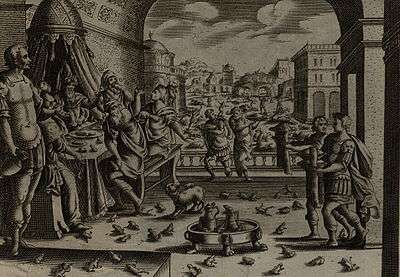
Exodus chapter 8
Rabbi Eleazar taught that when Exodus 8:2 (8:6 in the KJV) reports that "the frog came up, and covered the land of Egypt," it was initially just one frog, which bred prolifically and filled the land. The Tannaim disputed the matter. Rabbi Akiva said that one frog filled the whole of Egypt by breeding. But Rabbi Eleazar ben Azariah chastised Akiva for dabbling in aggadah, and taught that one frog croaked for others, and they joined the first frog.[115]
A Midrash interpreted the words of Proverbs 29:23, "A man's pride shall bring him low; but he that is of a lowly spirit shall attain to honor," to apply to Pharaoh and Moses, respectively. The Midrash taught that the words, "A man's pride shall bring him low," apply to Pharaoh, who in Exodus 5:2 haughtily asked, "Who is the Lord that I should hearken to His voice?" and so, as Psalm 136:15 reports, God "overthrew Pharaoh and his host." And the Midrash taught that the words, "but he that is of a lowly spirit shall attain to honor," apply to Moses, who in Exodus 8:5 (8:9 in the KJV), humbly asked Pharaoh, "Have this glory over me; at what time shall I entreat for you . . . that the frogs be destroyed," and was rewarded in Exodus 9:29 with the opportunity to say, "As soon as I am gone out of the city, I will spread forth my hands to the Lord [and] the thunders shall cease, neither shall there be any more hail."[116]
.jpg)
Rabbi Eleazar deduced from the magicians' recognition of "the finger of God" in Exodus 8:15 (8:19 in the KJV) that a demonic spirit cannot produce a creature less than a barleycorn in size. Rav Papa said that a spirit cannot even produce something the size of a camel, but a spirit can collect the elements of a larger object and thus produce the illusion of creating it, but a spirit cannot do even that with a smaller object.[117]
Rabbi Jose the Galilean reasoned that as the phrase "the finger of God" in Exodus 8:15 (8:19 in the KJV) referred to 10 plagues, "the great hand" (translated "the great work") in Exodus 14:31 (in connection with the miracle of the Reed Sea) must refer to 50 plagues upon the Egyptians, and thus to a variety of cruel and strange deaths.[118]
Rabbi Phinehas ben Hama reasoned that as the phrase "the finger of God" in Exodus 8:15 (8:19 in the KJV) referred to 10 plagues, "the hand of God" in Job 19:21 (in connection with Job's poverty) must refer to 50 plagues.[119]
Reading “the finger of God” in Exodus 8:15 (8:19 in the KJV), Rabbi Ishmael said that each of the five fingers of God's right hand appertain to the mystery of Redemption. Rabbi Ishmael said that God showed the little finger of the hand to Noah, pointing out how to make the Ark, as in Genesis 6:15, God says, “And this is how you shall make it.” With the second finger, next to the little one, God smote the Egyptians with the ten plagues, as Exodus 8:15 (8:19 in the KJV) says, “The magicians said to Pharaoh, ‘This is the finger of God.’” With the middle finger, God wrote the Tablets of the Law, as Exodus 31:18 says, “And He gave to Moses, when He had made an end of communing with him . . . tables of stone, written with the finger of God.” With the index finger, God showed Moses what the children of Israel should give for the redemption of their souls, as Exodus 30:13 says, “This they shall give . . . half a shekel for an offering to the Lord.” With the thumb and all the hand, God will in the future smite God's enemies (who Rabbi Ishmael identified as the children of Esau and Ishmael), as Micah 5:9 says, “Let your hand be lifted up above your adversaries, and let all your enemies be cut off.”[120]
.jpg)
A Midrash interpreted the words of Exodus 8:22 (8:26 in the KJV), "Lo, if we sacrifice the abomination of the Egyptians before their eyes, will they not stone us?" to teach that the Egyptians saw the lamb as a god. Thus, when God told Moses to slay the paschal lamb (as reflected in Exodus 12:21), Moses asked God how he could possibly do so, when the lamb was as Egyptian god. God replied that the Israelites would not depart from Egypt until they slaughtered the Egyptian gods before the Egyptians' eyes, so that God might teach them that their gods were really nothing at all. And thus God did so, for on the same night that God slew the Egyptian firstborn, the Israelites slaughtered their paschal lambs and ate them. When the Egyptians saw their firstborn slain and their gods slaughtered, they could do nothing, as Numbers 33:4 reports, "While the Egyptians were burying them whom the Lord had smitten among them, even all their firstborn; upon their gods also the Lord executed judgment."[121]
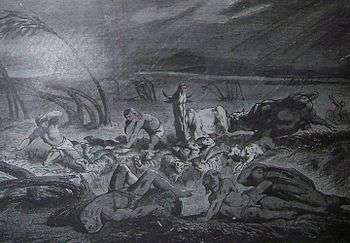
Exodus chapter 9
The Pirke De-Rabbi Eliezer taught that for every plague that God brought upon the Egyptians, the magicians also produced the plague, until God brought upon them the boils, and then the magicians were not able to stand to do likewise, as Exodus 9:11 says, "And the magicians could not stand before Moses because of the boils."[122]
A Midrash taught that when God perceived that Pharaoh did not relent after the first five plagues, God decided that even if Pharaoh now wished to repent, God would harden Pharaoh's heart in order to exact the whole punishment from him. Thus Exodus 9:12 reports that "the Lord hardened the heart of Pharaoh." And the Midrash explained that the reference in Exodus 9:12, "as the Lord had spoken to Moses," referred to God's prediction in Exodus 7:3 that "I will harden Pharaoh's heart."[123]
.jpg)
In Exodus 9:12, Pharaoh's heart is hardened. A Midrash catalogued the wide range of additional capabilities of the heart reported in the Hebrew Bible.[124] The heart speaks,[125] sees,[125] hears,[126] walks,[127] falls,[128] stands,[129] rejoices,[130] cries,[131] is comforted,[132] is troubled,[133] grows faint,[134] grieves,[135] fears,[136] can be broken,[137] becomes proud,[138] rebels,[139] invents,[140] cavils,[141] overflows,[142] devises,[143] desires,[144] goes astray,[145] lusts,[146] is refreshed,[147] can be stolen,[148] is humbled,[149] is enticed,[150] errs,[151] trembles,[152] is awakened,[153] loves,[154] hates,[155] envies,[156] is searched,[157] is rent,[158] meditates,[159] is like a fire,[160] is like a stone,[161] turns in repentance,[162] becomes hot,[163] dies,[164] melts,[165] takes in words,[166] is susceptible to fear,[167] gives thanks,[168] covets,[169] becomes hard,[170] makes merry,[171] acts deceitfully,[172] speaks from out of itself,[173] loves bribes,[174] writes words,[175] plans,[176] receives commandments,[177] acts with pride,[178] makes arrangements,[179] and aggrandizes itself.[180]
.jpg)
Exodus 9:13–34 sets forth the plague of hail. The Gemara told of the miracle of the hailstones (אַבְנֵי אֶלְגָּבִישׁ, avnei elgavish) of which Ezekiel 13:11, 13:13, and 38:22 speak. A Midrash taught that they were stones (אֲבָנִים, avanim) which remained suspended for the sake of a man (al gav ish) and came down for the sake of a man. The hailstones remained suspended for the sake of a man — this was Moses, of whom Numbers 12:3 says, "Now the man Moses was very meek," and Exodus 9:33 says, "And the thunder and hail ceased, and the rain poured not upon the earth." The hailstones came down for the sake of a man — this was Joshua, of whom Numbers 27:18 says, "Take Joshua the son of Nun, a man in whom there is spirit," and Joshua 10:11 says, "And it came to pass as they fled from before Israel, while they were at the descent of Beth-Horon, that the Lord cast down great stones."[181]
Rabbi Nechunia, son of Hakkanah, taught that God killed Pharaoh, and then because of Pharaoh's repentance, delivered him from among the dead. Rabbi Nechunia deduced that Pharaoh had died from Exodus 9:15, in which God told Moses to tell Pharaoh, "For now I had put forth my hand, and smitten you."[182]
Reading Exodus 9:20, “Those among Pharaoh’s courtiers who feared the Lord’s word brought their slaves and livestock indoors to safety,” the Midrash HaGadol taught that one can surely draw the inference that if those who fear God on a particular occasion are saved from punishment, how much more will those who fear God all their life be saved.[183]
The Pharisees noted that while in Exodus 5:2 Pharaoh asked who God was, once God had smitten him, in Exodus 9:27 Pharaoh acknowledged that God was righteous. Citing this juxtaposition, the Pharisees complained against heretics who placed the name of earthly rulers above the name of God.[184]
Interpreting Exodus 9:34, "And when Pharaoh saw that the rain and the hail and the thunders had ceased, he sinned yet more," a Midrash taught that so it always is with the wicked: As long as they are in trouble, they humble themselves. But as soon as trouble passes, they return to their perversity.[185]
In medieval Jewish interpretation
The parashah is discussed in these medieval Jewish sources:[186]
Exodus chapter 6
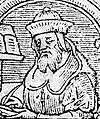
Rashi taught that God's words "I am the Lord" in Exodus 6:2 meant that God was faithful to recompense all those who followed God. Thus "I am the Lord" means that God is faithful to exact payment when it is stated in conjunction with an act warranting punishment, as in Leviticus 19:12, "or you will profane the name of your God; I am the Lord." And "I am the Lord" means that God is faithful to give reward when it is stated in conjunction with the fulfillment of commandments, as in Leviticus 22:31, "And you shall keep My commandments and perform them; I am the Lord."[187]
The 12th century Spanish commentator Abraham ibn Ezra read God's statement "and I appeared" in Exodus 6:3 to indicate that the Patriarchs received their prophesies in visions of the night.[188]
Saadia Gaon taught that the word "only" was omitted from the statement "I did not make Myself known to them by My name YHVH" in Exodus 6:3, so that one should read Exodus 6:3 to say, "I did not make Myself known to them only by My name YHVH," for God also used the Name "El Shaddai."[189]

Ibn Ezra quotes Rabbi Joshua as saying that Abraham and Jacob literally did not know the Name יְהוָה, YHVH, but Moses filled it in when writing down the Torah. However, he disagrees with this, asking how Moses could dare to write a name that God had not uttered.[190]
Rashi noted that Exodus 6:3 does not say, "but My Name YHVH I did not inform them," but, "I did not become known." God thus meant that God was not recognized by them with God's attribute of keeping faith, because of which God is called YHVH, which means that God is faithful to carry out God's words, for God made promises to them, but did not fulfill them while they were alive.[191]
Nachmanides read God to say in Exodus 6:3 that God appeared to the Patriarchs in God's form of El Shaddai, in which God performs hidden miracles that appear to the observer as part of the natural order. But God did not appear to them in God's form of YHVH, with which God called existence into being and in which God created open changes in nature.[192]
Exodus chapter 7
Reading God's statement in Exodus 7:3, "I will harden Pharaoh's heart," Ibn Ezra asked: If God hardened Pharaoh's heart, what was his transgression and what was his sin? Ibn Ezra answered that God granted people wisdom and implanted in their hearts the intelligence to receive power from on high to add to their good or diminish the evil destined to befall them.[193]
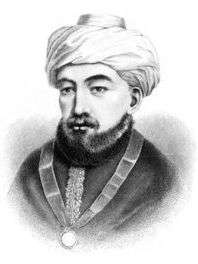
Reading God's statement in Exodus 7:3 that "I will harden Pharaoh's heart," the report of Exodus 9:12 that "the Lord hardened the heart of Pharaoh," and similar statements in Exodus 4:21; 10:1, 20, 27; 11:10; and 14:4, 8, and 17, Maimonides concluded that it is possible for a person to commit such a great sin, or so many sins, that God decrees that the punishment for these willing and knowing acts is the removal of the privilege of repentance (תְשׁוּבָה, teshuvah). The offender would thus be prevented from doing repentance, and would not have the power to return from the offense, and the offender would die and be lost because of the offense. Maimonides read this to be what God said in Isaiah 6:10, "Make the heart of this people fat, and make their ears heavy, and their eyes weak, lest they see with their eyes and hear with their ears, and their hearts will understand, do repentance and be healed." Similarly 2 Chronicles 36:16 reports, "They ridiculed the messengers of God, disdained His words and insulted His prophets until the anger of God rose upon the people, without possibility of healing." Maimonides interpreted these verses to teach that they sinned willingly and to such an egregious extent that they deserved to have repentance withheld from them. And thus because Pharaoh sinned on his own at the beginning, harming the Jews who lived in his land, as Exodus 1:10 reports him scheming, "Let us deal craftily with them," God issued the judgment that repentance would be withheld from Pharaoh until he received his punishment, and therefore God said in Exodus 14:4, "I will harden the heart of Pharaoh." Maimonides explained that God sent Moses to tell Pharaoh to send out the Jews and do repentance, when God had already told Moses that Pharaoh would refuse, because God sought to inform humanity that when God withholds repentance from a sinner, the sinner will not be able to repent. Maimonides made clear that God did not decree that Pharaoh harm the Jewish people; rather, Pharaoh sinned willifully on his own, and he thus deserved to have the privilege of repentance withheld from him.[194]
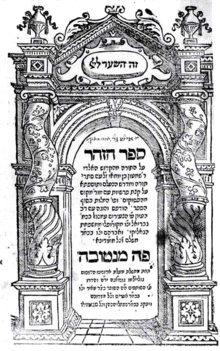
The Zohar taught that the “mixed multitude” (רַב עֵרֶב, erev rav) mentioned in Exodus 12:38 consisted entirely of Egyptian sorcerers and magicians, who sought to oppose God’s works, as Exodus 7:11 reports, “And the magicians of Egypt, they also did in like manner with their enchantments.” When they beheld the signs and the wonders that Moses performed, they came to Moses to be converted. God advised Moses not to accept them, but Moses argued that now that they had seen God’s power, they desired to accept the Israelites’ Faith, and if they saw God’s power every day, they would learn that there is no God like God. So Moses accepted them. Exodus 12:38 called them a “mixed multitude” because they consisted of all the grades of Egyptian magicians, at their head being Jannes and Jambres. During the day, these wizards practiced their enchantments, and after sunset, they made observations of the heavens until the middle of the ninth hour, which was called the “great evening” (רַב עֵרֶב, erev rav, which means both “great multitude” and “great evening”). The lesser magicians then made observation after that until midnight. The Egyptians, who had great faith in the chief wizards, thus called them the “great evening” (רַב עֵרֶב, erev rav).[195]
Exodus chapter 8
Rashi read the words of Pharaoh’s magicians in Exodus 8:15, “This is the finger of God,” to indicate that they perceived that this plague was not the result of sorcery but the Omnipresent.[196]
Rashbam, however, read Exodus 8:15, “This is the finger of God,” to indicate that the magicians assessed that the plague was a natural disaster not caused by Moses and Aaron, for if the lice had resulted from the sorcery of Moses and Aaron, then the magicians would have been able to replicate it.[197] Ibn Ezra and Hezekiah ben Manoah (Hizkuni) similarly read the magicians’ remark to indicate that the magicians thought that a natural disaster had caused the plague, because the magicians said, “This is the finger of God,” and not, “This is the finger of the Lord.”[198]
Nachmanides, however, disagreed with Ibn Ezra’s reading, arguing that a matter of chance is not called “the finger of God,” only a punishment from God is called that, as in 1 Samuel 12:15, “the hand of the Lord.” Further, Nachmanides noted that in the next plagues, Pharaoh no longer called on the magicians to do the same thing, indicating that the magicians had already conceded that the plagues were God’s doing.[199]
Exodus chapter 9
Saadia Gaon read the words, “He that feared the word of the Lord among the servants of Pharaoh,” in Exodus 9:20 to indicate that those servants of Pharaoh feared God’s strength and power.[200]
In modern interpretation
The parashah is discussed in these modern sources:
Exodus chapter 6
Israeli Bible scholar Nahama Leibowitz identified the following chiastic structure in God's speech to Moses in Exodus 6:2–8:[201]
2And God spoke to Moses, and said to him:
- A: "I am the Lord;
- B: 3And I appeared to Abraham, to Isaac, and to Jacob, as God Almighty, but by My name YHWH I made Me not known to them.
- C: 4And I have also established My covenant with them, to give them the land of Canaan, the land of their sojournings, wherein they sojourned.
- D: 5And moreover I have heard the groaning of the children of Israel, whom the Egyptians keep in bondage; and I have remembered My covenant.
- E: 6Therefore say to the children of Israel: I am the Lord, and I will bring you out from under the burdens of the Egyptians, and I will deliver you from their bondage, and I will redeem you with an outstretched arm, and with great judgments;
- D1: 7And I will take you to Me for a people, and I will be to you a God; and you shall know that I am the Lord your God, who brought you out from under the burdens of the Egyptians.
- D: 5And moreover I have heard the groaning of the children of Israel, whom the Egyptians keep in bondage; and I have remembered My covenant.
- C1: 8And I will bring you in to the land, concerning which I lifted up My hand to give it
- C: 4And I have also established My covenant with them, to give them the land of Canaan, the land of their sojournings, wherein they sojourned.
- B1: to Abraham, to Isaac, and to Jacob; and I will give it you for a heritage:
- B: 3And I appeared to Abraham, to Isaac, and to Jacob, as God Almighty, but by My name YHWH I made Me not known to them.
- A1: I am the Lord."
Professor Robert Alter of the University of California, Berkeley, wrote that the designation אֵל שַׁדָּי, El Shaddai, in Exodus 6:3, also used five times in the Patriarchal Tales, is an archaic, evidently Canaanite combination of divine names. אֵל, El, was the high god of the Canaanite pantheon (although the Hebrew word is also a common noun meaning “god”), and some scholars link שַׁדָּי, Shaddai, with a term for “mountain,” and others associate it with fertility.[202]
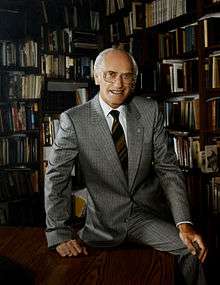
Rabbi Gunther Plaut noted the difficulty that Exodus 6:3–4 says that it is יְהוָה, YHVH, who guarantees the covenant made with the ancestors, although they did not know God by this Name, but this contradicts the frequent occurrence of the name יְהוָה, YHVH, in Genesis, implying that the forefathers knew the Name. Plaut reports that Biblical scholars have attempted to solve this contradiction in various ways, many positing that Exodus 6 belongs to the Priestly source, which held that the Patriarchs knew God only as Elohim or El Shaddai, and that God first disclosed the Name יְהוָה, YHVH, to Moses. According to this theory, the passages in Genesis that use the Name יְהוָה, YHVH, and the passages in Exodus 3 that refer to יְהוָה, YHVH, are assigned to the J tradition. Adherents of this theory argue that in Exodus 6:3, the P school connected יְהוָה, YHVH, with Moses to establish the legitimacy of the priestly hierarchy.[203] Acknowledging that this explanation does not address the text as it is now, Plaut presented the alternative explanation (which Plaut attributed to the Israeli scholar Yehezkel Kaufmann) that Moses and the people had since patriarchal time known the Name יְהוָה, YHVH, as God's name, but this knowledge had hardly been more than a “customary appellation.” In Exodus 6, however, after his first trials and failures, Moses confronted God again, and this time God revealed the Name more fully, which is to say that Moses saw God more clearly than before, in a new light.[204] Turning to the etymology of the Name, Plaut reported that the most widely accepted explanation connects the Name with the word hayah, "to be", a causative form of which could be Yahveh, “one who causes to be.” Another form could be Yahuah, “he who indeed will (show himself to) be,” or “he who proves himself.” Plaut reported a different theory holds that the name was read Yahuh, a version of Yehu, a form that occurs several times independently in the Bible as יהרא and frequently as a prefix or suffix to proper names. According to Martin Buber, Yahu was a kind of “primitive sound,” an exclamation denoting awe, recognition, and affirmation: “Oh is the one!” or “Yah is the one!” or “Yah is!” or “Yah exists!” Finally, Plaut related yet another approach, seeing יְהוָה, YHVH, as having developed from a cultic name connected with El, perhaps El du Yahwi — “El who creates” — and that in time the Name Yahwi split off from El, ousting the Name El from preeminence.[205]
Sarna and Tigay noted that Exodus 6:7, “I will take you to Me for a people, and I will be to you a God,” prefigures the covenant that God would establish at Sinai.[206]
Alter noted that the idea in Exodus 6:7, “that I am the Lord your God Who takes you out from under the burdens of Egypt,” is emphasized repeatedly in the Torah and later books of the Bible. Alter called “the cornerstone of Israelite faith” that God had proven God's divinity and attachment to Israel by liberating the Israelites from Egyptian slavery. Alter reported that some modern scholars, arguing from the absence of Egyptian evidence on any Hebrew slave population or any mention of an exodus, have raised doubts about whether the Hebrews were ever in Egypt. Alter concluded that the story is surely a schematization and simplification of complex historical processes. Alter viewed it quite likely that a sizeable segment of the Hebrew people remained in the high country of eastern Canaan and never went down to Egypt. Yet Alter also found it hard to imagine that the Israelites would have invented a story of national origins involving the humiliation of slavery without some kernel of historical memory.[207]
Exodus chapter 7
Professor Greta Hort of the University of Melbourne in the mid 20th century argued that the plagues concentrated within a period of about 12 months, based on the report of Exodus 7:7 that Moses was 80 years old when he first spoke with pharaoh and the report of Deuteronomy 34:7 that Moses was 120 years old when he died, after spending 40 years in the wilderness.[208]
Sarna noted that Aaron, not Moses, turned his rod into a snake in Exodus 7:10. Sarna explained that Moses thus tacitly asserted his equal status with Pharaoh. Moses came to negotiate with Pharaoh as the representative of the people of Israel. Just as Pharaoh had his magicians, Moses had his assistant, Aaron. Sarna noted that in the narratives of the Ten Plagues, Aaron acted only as long as the Egyptian magicians appeared present. After their ingenuity failed them and they faded from the story, Moses acted personally to bring about the remaining plagues.[209]
Professor Everett Fox of Clark University noted that “glory” (כְּבוֹד, kevod) and “stubbornness” (כָּבֵד לֵב, kaved lev) are leading words throughout the book of Exodus that give it a sense of unity.[210] Similarly, Professor William Propp of the University of California, San Diego, identified the root kvd — connoting heaviness, glory, wealth, and firmness — as a recurring theme in Exodus: Moses suffered from a heavy mouth in Exodus 4:10 and heavy arms in Exodus 17:12; Pharaoh had firmness of heart in Exodus 7:14; 8:11, 28; 9:7, 34; and 10:1; Pharaoh made Israel’s labor heavy in Exodus 5:9; God in response sent heavy plagues in Exodus 8:20; 9:3, 18, 24; and 10:14, so that God might be glorified over Pharaoh in Exodus 14:4, 17, and 18; and the book culminates with the descent of God’s fiery Glory, described as a “heavy cloud,” first upon Sinai and later upon the Tabernacle in Exodus 19:16; 24:16–17; 29:43; 33:18, 22; and 40:34–38.[211]
Plaut reported that scholars generally agree that the term “Hebrew” (עִברִי, Ivri), as in Exodus 7:16 and 9:1 and 13, came from the name of a group called Habiru or Apiru, people who had lost their status in the community from which they came, and who were not necessarily related except by common fate.[212] Plaut wrote that the Habiru were a class of people who lived in the Fertile Crescent during the 19th to 14th centuries B.C.E. who may originally have come from Arabia, became prominent in Mesopotamia, and later spread to Egypt. The Habiru followed distinct occupations, particularly mercenaries and administrators. Although at first they were nomads or seminomads, they later settled, but were usually considered foreigners and maintaining their group identity. The term Habiru referred not so much to an ethnic or linguistic group as to a social or political group. Plaut reported that the words Habiru and “Hebrew” (עִברִי, Ivri) appear to share a common linguistic root. Plaut concluded that Israelites in Egypt likely occupied positions similar to, or because of familial ties were identified with, the Habiru. When non-Israelites repeatedly applied the term to the Israelites, the Israelites themselves began to use the name Habiru, which they pronounced Ivri. Plaut considered it possible that for some time the term Ivri was used only when the Israelites spoke of themselves to outsiders and when outsiders referred to them. Thus Genesis 14:13 calls Abram Ivri vis-a-vis an outsider, and Jonah says, "I am an Ivri,” when asked his identity by non-Israelite sailors in Jonah 1:9, but otherwise Israelites referred to themselves by their tribes (for example, Judah or Ephraim) or by their common ancestor, Israel.[213]
Plaut reported that most moderns take the view that the plague stories are unacceptable as fact and must be deemed legendary and unhistorical.[214] Plaut argued that it was a mistake to consider the stories literally rather than as “essentially interpretive and legendary” — asserting that the release of the Israelites from slavery was unprecedented and could only be explained by crediting God.[215] Plaut suggested that there was “possibly or even likely” a historical kernel that the biblical tradition transposed into the moral religious realm. Thus Plaut noted that some claim that the bloodiness of the Nile was caused by special deposits that the river picked up from the mountains (hence the name "Red Nile” for one branch); that frogs accompanied a large-scale inundation; and that lice, gnats, and insects regularly infested the area.[216] Plaut concluded that the plague stories teach: “Israel's redemption was the ultimate marvel, and it was caused by God. To bring it about, nature itself was harnessed, the drama of the plagues was unfolded, and the ground was laid for an experience that forever after was etched into the hearts of the people and their descendants.”[217]
Professor John J. Collins of Yale Divinity School reported that some scholars have suggested that the plague stories contain a reminiscence of a mid-fourteenth century BCE epidemic referred to as “the Asiatic illness.”[218]
Collins argued that the plague stories show that Exodus is not only the story of the liberation of Israel, but also of the defeat and humiliation of the Egyptians, and thus involved “less than edifying” nationalistic, ethnic vengeance.[219]
Sarna suggested that the biblical narrator might have construed the affliction of the Nile’s waters and the plague of frogs as a kind of retribution for the pharaoh’s decrees ordering the killing of male Israelites at birth and their drowning in the Nile.[220]
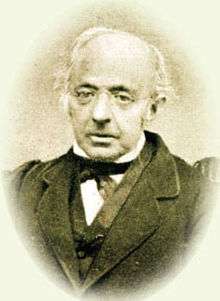
Exodus chapter 8
Reading the words of Pharaoh’s magicians in Exodus 8:15, “This is the finger of God,” Samuel David Luzzatto (Shadal) wrote that although Pharaoh must have in his heart realized that the magicians were correct (and Moses was correct), Pharaoh carried on “business as usual,” as is the habit of atheists.[221]
Alter noted that the narrative preceding Exodus 8:15 repeatedly spoke of God’s “hand” or “arm,” but Pharaoh’s magicians appear to concede a lesser trace of divine action in mentioning God’s “finger.”[222]
Exodus chapter 9
Reading the report of Exodus 9:6 that “all the livestock of Egypt died,” but noting that Exodus 9:10 reports that boils subsequently struck the animals, Plaut concluded that Exodus 9:6 must be taken as hyperbole.[223]
Jacob ben Asher (the Baal Ha-Turim) read the words, “He that feared,” in Exodus 9:20 to indicate that the Egyptians were fearful because of the sins they had committed.[224]
The 19th century German-English Jewish scholar Moritz Markus Kalisch reported an interpretation that Exodus 9:20 indicated a test by Moses of how far the fear of God had spread among the Egyptians.[225]
The early 20th century German Rabbi and scholar Benno Jacob read Exodus 9:20 to indicate that some of Pharaoh’s servants had become frightened of God’s warning through Moses.[226]
Reading Exodus 9:20, “Whoever feared the Lord’s word,” Alter wrote that whereas elsewhere, this idiom indicates piety (as in “God-fearing”), here it has been stripped down to its literal meaning of whoever was struck with terror by God’s grim threat.[227]
In critical analysis
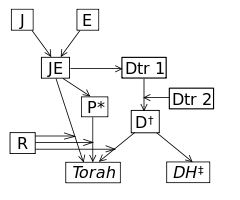
Some scholars who follow the Documentary Hypothesis find evidence of three or even four separate sources in the parashah. Professor Walter Brueggemann, formerly of Columbia Theological Seminary, reported that older source analysis saw Exodus 6:2–30 as an insertion by the Priestly source, addressed to a community in exile (or just out of exile), appealing to very old tradition to create a sense of structured, stable reality to give coherence, order, and legitimacy to communal life.[228] Professor Richard Elliott Friedman, of the University of Georgia, however, saw four sources in Exodus 6 alone. Friedman saw the opening verse of Exodus 6:1 to have been composed by the Elohist (sometimes abbreviated E) who wrote in the north, in the land of the Tribe of Ephraim, possibly as early as the second half of the 9th century BCE.[229] Friedman agreed with Brueggemann in attributing Exodus 6:2–10 and 30 to the Priestly source who wrote in the 6th or 5th century BCE.[230] But Friedman attributed Exodus 6:12–13 and 26–28 to a later Redactor (sometimes abbreviated R).[231] And Friedman attributed the genealogy of Exodus 6:14–25 to the Book of Records or some other separate source document, from which Friedman postulates that the Redactor chose to use only the first section covering genealogies from Reuben to Levi, stopping at Aaron.[232]
In the balance of the parashah, Friedman attributed Exodus 7:14–18, 20b–21, and 23–29; 8:3b–11a and 16–28; and 9:1–7 and 13–34; to the Elohist; Exodus 7:1–13, 19–20a, and 22; 8:1–3a and 12–15; and 9:8–12 to the Priestly source; and Exodus 8:11b and 9:35 to the Redactor.[233] For a color-coded display of verses according to this hypothesis, see the display of Exodus according to the Documentary Hypothesis at Wikiversity.
Commandments
According to Maimonides and Sefer ha-Chinuch, there are no commandments in the parashah.[234]
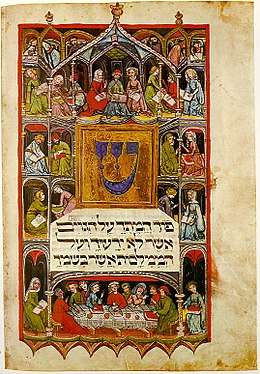
In the liturgy
Reading the Passover Haggadah, in the magid section of the Seder, many Jews remove drops of wine from their cups for each of the ten plagues in Exodus 7:14–12:29.[235]
Next, the Haggadah recounts the reasoning of Rabbi Jose the Galilean that as the phrase "the finger of God" in Exodus 8:15 referred to 10 plagues, "the great hand" (translated "the great work") in Exodus 14:31 must refer to 50 plagues upon the Egyptians.[236]
And the haggadah in the magid section quotes Exodus 9:3 to elucidate the term "a mighty hand" in Deuteronomy 26:8, interpreting the "mighty hand" to mean the plague of pestilence on the Egyptian livestock.[237]
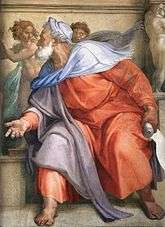
Haftarah
Generally
The haftarah for the parashah is Ezekiel 28:25–29:21.
Connection to the Parashah
Both the parashah and the haftarah describe God's instructions to a prophet to confront the Pharaoh of Egypt and bring on Israel's redemption. Both the parashah and the haftarah address God's judgments (shefatim) against Pharaoh and Egypt.[238] A monster (tannin) plays a role in both the parashah and the haftarah: In the parashah, God turns Moses' rod into a monster;[239] the haftarah describes Pharaoh as a monster.[240] In both the parashah and the haftarah, God attacks the river[241] and kills fish.[242] In both the parashah and the haftarah, God's actions would cause the Egyptians to know (ve-yade'u) God.[243] And in both the parashah and the haftarah, God proclaims, "I am the Lord."[244]
On Shabbat Rosh Chodesh
When the parashah coincides with Shabbat Rosh Chodesh (as it does in 2013 and 2017), the haftarah is Isaiah 66:1–24.
Notes
- "Torah Stats — Shemoth". Akhlah Inc. Retrieved July 6, 2013.
- "Parashat Vaera". Hebcal. Retrieved January 8, 2015.
- See, e.g., Menachem Davis, editor, The Schottenstein Edition Interlinear Chumash: Shemos/Exodus (Brooklyn: Mesorah Publications, 2008), pages 31–57.
- Exodus 6:2–4.
- Exodus 6:6–8.
- Exodus 6:9.
- See, e.g., Menachem Davis, editor, The Schottenstein Edition Interlinear Chumash: Shemos/Exodus, page 33.
- Exodus 6:10–12.
- See, e.g., Menachem Davis, editor, The Schottenstein Edition Interlinear Chumash: Shemos/Exodus, page 34.
- See, e.g., Menachem Davis, editor, The Schottenstein Edition Interlinear Chumash: Shemos/Exodus, pages 34–35.
- Exodus 6:14–25.
- See, e.g., Menachem Davis, editor, The Schottenstein Edition Interlinear Chumash: Shemos/Exodus, page 37.
- Exodus 6:29–30.
- Exodus 7:1–2.
- Exodus 7:3–5.
- Exodus 7:6.
- Exodus 7:7.
- See, e.g., Menachem Davis, editor, The Schottenstein Edition Interlinear Chumash: Shemos/Exodus, page 39.
- Exodus 7:9–10.
- Exodus 7:11–12.
- Exodus 7:13.
- See, e.g., Menachem Davis, editor, The Schottenstein Edition Interlinear Chumash: Shemos/Exodus, page 40.
- Exodus 7:14–18.
- See, e.g., Menachem Davis, editor, The Schottenstein Edition Interlinear Chumash: Shemos/Exodus, page 41.
- Exodus 7:19.
- Exodus 7:20–21.
- Exodus 7:22–23.
- Exodus 7:25.
- See, e.g., Menachem Davis, editor, The Schottenstein Edition Interlinear Chumash: Shemos/Exodus, page 43.
- Exodus 7:26–8:2.
- Exodus 8:3.
- Exodus 8:4.
- Exodus 8:5–6.
- See, e.g., Menachem Davis, editor, The Schottenstein Edition Interlinear Chumash: Shemos/Exodus, page 45.
- Exodus 8:7–11.
- See, e.g., Menachem Davis, editor, The Schottenstein Edition Interlinear Chumash: Shemos/Exodus, page 46.
- Exodus 8:12–13.
- Exodus 8:14.
- Exodus 8:15.
- See, e.g., Menachem Davis, editor, The Schottenstein Edition Interlinear Chumash: Shemos/Exodus, page 47.
- Exodus 8:16–18.
- See, e.g., Menachem Davis, editor, The Schottenstein Edition Interlinear Chumash: Shemos/Exodus, page 48.
- Exodus 8:19–20.
- Exodus 8:21–23.
- Exodus 8:24.
- Exodus 8:27–28.
- See, e.g., Menachem Davis, editor, The Schottenstein Edition Interlinear Chumash: Shemos/Exodus, page 50.
- Exodus 9:1–6.
- Exodus 9:7.
- See, e.g., Menachem Davis, editor, The Schottenstein Edition Interlinear Chumash: Shemos/Exodus, page 51.
- Exodus 9:8–10.
- Exodus 9:12.
- See, e.g., Menachem Davis, editor, The Schottenstein Edition Interlinear Chumash: Shemos/Exodus, page 52.
- Exodus 9:13–16.
- See, e.g., Menachem Davis, editor, The Schottenstein Edition Interlinear Chumash: Shemos/Exodus, page 53.
- Exodus 9:17–19.
- Exodus 9:20–21.
- See, e.g., Menachem Davis, editor, The Schottenstein Edition Interlinear Chumash: Shemos/Exodus, page 54.
- Exodus 9:22–26.
- Exodus 9:27–28.
- Exodus 9:29–30.
- Exodus 9:31–32.
- See, e.g., Menachem Davis, editor, The Schottenstein Edition Interlinear Chumash: Shemos/Exodus, pages 56–57.
- Exodus 9:33–35.
- See, e.g., Menachem Davis, editor, The Schottenstein Edition Interlinear Chumash: Shemos/Exodus, page 57.
- See, e.g., Richard Eisenberg, "A Complete Triennial Cycle for Reading the Torah," Proceedings of the Committee on Jewish Law and Standards of the Conservative Movement: 1986–1990 (New York: The Rabbinical Assembly, 2001), pages 383–418.
- W. Gunther Plaut, The Torah: A Modern Commentary: Revised Edition, revised edition edited by David E.S. Stern (New York: Union for Reform Judaism, 2006), page 388.
- For more on inner-Biblical interpretation, see, e.g., Benjamin D. Sommer, "Inner-biblical Interpretation," in The Jewish Study Bible: Second Edition, edited by Adele Berlin and Marc Zvi Brettler (New York: Oxford University Press, 2014), pages 1835–41.
- Nahum M. Sarna, The JPS Torah Commentary: Exodus: The Traditional Hebrew Text with the New JPS Translation, page 32 (Philadelphia: Jewish Publication Society, 1991). ISBN 0-8276-0327-4.
- Jeffrey H. Tigay. “Exodus.” In The Jewish Study Bible: Second Edition. Edited by Adele Berlin and Marc Zvi Brettler, page 108. Bruce Wells. "Exodus." In Zondervan Illustrated Bible Backgrounds Commentary. Edited by John H. Walton, volume 1, page 185. Grand Rapids, Michigan: Zondervan, 2009. ISBN 978-0-310-25573-4.
- For more on early nonrabbinic interpretation, see, e.g., Esther Eshel. "Early Nonrabbinic Interpretation." In The Jewish Study Bible: Second Edition. Edited by Adele Berlin and Marc Zvi Brettler, pages 1841–59.
- Philo. On the Change of Names Archived 2009-02-20 at the Wayback Machine chapter 2, paragraphs 11–13. Alexandria, Egypt, early 1st century CE. Reprinted in, e.g., The Works of Philo: Complete and Unabridged, New Updated Edition. Translated by Charles Duke Yonge, page 342. Peabody, Massachusetts: Hendrickson Publishers, 1993. ISBN 0-943575-93-1.
- For more on classical rabbinic interpretation, see, e.g., Yaakov Elman, "Classical Rabbinic Interpretation," in The Jewish Study Bible: Second Edition, edited by Adele Berlin and Marc Zvi Brettler, pages 1859–78.
- Exodus Rabbah 6:1 (10th century), reprinted in, e.g., Simon M. Lehrman, translator, Midrash Rabbah: Exodus (London: Soncino Press, 1939), volume 3, pages 103, 105.
- See Genesis 17:1 and 48:3.
- Exodus Rabbah 6:4, reprinted in, e.g., Simon M. Lehrman, translator, Midrash Rabbah: Exodus, volume 3, pages 107–09. See also Mekhilta of Rabbi Simeon, Tractate Sanya, chapter 2, paragraph 3:1 (Land of Israel, 5th century), reprinted in, e.g., W. David Nelson, translator, Mekhilta de-Rabbi Shimon bar Yohai (Philadelphia: Jewish Publication Society, 2006), page 8 (Rabbi Akiva said that "therefore" implies an oath).
- Babylonian Talmud Sanhedrin 90b (Babylonia, 6th century), reprinted in, e.g., Koren Talmud Sanhedrin • Part Two, commentary by Adin Even-Israel (Steinsaltz) (Jerusalem: Koren Publishers, 2017), volume 30, page 275; and reprinted in, e.g., Talmud Bavli, elucidated by Asher Dicker, Joseph Elias, and Dovid Katz; edited by Yisroel Simcha Schorr and Chaim Malinowitz (Brooklyn: Mesorah Publications, 1995), volume 49, page 90b2.
- Babylonian Talmud Rosh Hashanah 11b, reprinted in, e.g., Talmud Bavli, elucidated by Abba Zvi Naiman, Israel Schneider, Moshe Zev Einhorn, and Eliezer Herzka; edited by Yisroel Simcha Schorr and Chaim Malinowitz (Brooklyn: Mesorah Publications, 1999), volume 18, page 11b1.
- Babylonian Talmud Berakhot 38a, reprinted in, e.g., Koren Talmud Bavli: Tractate Berakhot, commentary by Adin Even-Israel (Steinsaltz) (Jerusalem: Koren Publishers, 2012), volume 1, page 256.
- Jerusalem Talmud Pesachim 82b (Land of Israel, circa 400 CE), reprinted in, e.g., Talmud Yerushalmi, elucidated by Michoel Weiner, Chaim Ochs, Zev Meisels, Mordechai Smilowitz, Gershon Hoffman, Yehuda Jaffa, Avrohom Neuberger, and Mendy Wachsman; edited by Chaim Malinowitz, Yisroel Simcha Schorr, and Mordechai Marcus (Brooklyn: Mesorah Publications, 2011), volume 19, page 82b1; and reprinted in, e.g., The Jerusalem Talmud: A Translation and Commentary, edited by Jacob Neusner and translated by Jacob Neusner, Tzvee Zahavy, B. Barry Levy, and Edward Goldman (Peabody, Massachusetts: Hendrickson Publishers, 2009). See also Exodus Rabbah 6:4. Reprinted in, e.g., Midrash Rabbah: Exodus. Translated by Simon M. Lehrman, volume 3, pages 107–09. Genesis Rabbah 88:5. Land of Israel, 5th century. Reprinted in, e.g., Midrash Rabbah: Genesis. Translated by Harry Freedman and Maurice Simon, volume 2, pages 816–17. London: Soncino Press, 1939. ISBN 0-900689-38-2.
- Mishnah Pesachim 10:1. Land of Israel, circa 200 CE. Reprinted in, e.g., The Mishnah: A New Translation. Translated by Jacob Neusner, page 249. New Haven: Yale University Press, 1988. ISBN 0-300-05022-4. Babylonian Talmud Pesachim 99b. Reprinted in, e.g., Koren Talmud Bavli: Pesaḥim • Part Two. Commentary by Adin Even-Israel (Steinsaltz), volume 7, page 215. Jerusalem: Koren Publishers, 2013. ISBN 978-965-301-569-2.
- Babylonian Talmud Sanhedrin 111a. Reprinted in, e.g., Koren Talmud Sanhedrin • Part Two. Commentary by Adin Even-Israel (Steinsaltz), volume 30, page 397.
- Babylonian Talmud Bava Batra 117b. Reprinted in, e.g., Koren Talmud Bavli: Bava Batra • Part Two. Commentary by Adin Even-Israel (Steinsaltz), volume 28, page 119. Jerusalem: Koren Publishers, 2016. ISBN 978-965-301-589-0.
- Exodus Rabbah 6:5. Reprinted in, e.g., Midrash Rabbah: Exodus. Translated by Simon M. Lehrman, volume 3, page 109.
- Genesis Rabbah 92:7. Reprinted in, e.g., Midrash Rabbah: Genesis. Translated by Harry Freedman and Maurice Simon, volume 2.
- Pirke De-Rabbi Eliezer, chapter 29. Early 9th century. Reprinted in, e.g., Pirke de Rabbi Eliezer. Translated and annotated by Gerald Friedlander, pages 206–07. London, 1916. Reprinted New York: Hermon Press, 1970. ISBN 0-87203-183-7. See also Genesis Rabbah 46:5. Reprinted in, e.g., Midrash Rabbah: Genesis. Translated by Harry Freedman and Maurice Simon, volume 1, page 392. (Rabbi Akiva counted four kinds of orlah). And Tractate Orlah in the Mishnah, Tosefta, and Jerusalem Talmud deals with the uncircumcision of trees based on Leviticus 19:23–25. Mishnah Orlah 1:1–3:9. Reprinted in, e.g., The Mishnah: A New Translation. Translated by Jacob Neusner, pages 158–66. Tosefta Orlah 1:1–8. Land of Israel, circa 300 CE. Reprinted in, e.g., The Tosefta: Translated from the Hebrew, with a New Introduction. Translated by Jacob Neusner, volume 1, pages 341–43. Peabody, Massachusetts: Hendrickson Publishers, 2002. ISBN 1-56563-642-2. Jerusalem Talmud Orlah 1a–42a. Reprinted in, e.g., Talmud Yerushalmi. Elucidated by Mendy Wachsman, Gershon Hoffman, Abba Zvi Naiman, Michoel Weiner, David Azar, Menachem Goldberger, and Avrohom Neuberger; edited by Chaim Malinowitz and Yisroel Simcha Schorr, volume 12. Brooklyn: Mesorah Publications, 2007. ISBN 1-4226-0240-0.
- See Exodus 6:13, 7:8, 9:8, 12:1, 12:43, 12:50; Leviticus 11:1, 13:1, 14:33, 15:1; Numbers 2:1, 4:1, 4:17 14:26, 16:20, 19:1, 20:12, 20:23.
- Numbers Rabbah 2:1. 12th century. Reprinted in, e.g., Midrash Rabbah: Numbers. Translated by Judah J. Slotki, volume 5, page 22. London: Soncino Press, 1939. ISBN 0-900689-38-2.
- Jerusalem Talmud Rosh Hashanah 20b. Reprinted in, e.g., Talmud Yerushalmi. Elucidated by Gershon Hoffman, Mordechai Smilowitz, Yehuda Jaffa, Mordechai Stareshefsky, Chaim Ochs, and Abba Zvi Naiman; edited by Chaim Malinowitz, Yisroel Simcha Schorr, and Mordechai Marcus, volume 24, page 20b4. Brooklyn: Mesorah Publications, 2012. ISBN 1-4226-0254-0. And reprinted in, e.g., The Jerusalem Talmud: A Translation and Commentary. Edited by Jacob Neusner and translated by Jacob Neusner, Tzvee Zahavy, B. Barry Levy, and Edward Goldman. Peabody, Massachusetts: Hendrickson Publishers, 2009. ISBN 978-1-59856-528-7.
- Exodus Rabbah 7:3. Reprinted in, e.g., Midrash Rabbah: Exodus. Translated by Simon M. Lehrman, volume 3, page 111.
- Midrash Tanhuma Korah 1. 6th–7th centuries. Reprinted in, e.g., Metsudah Midrash Tanchuma. Translated and annotated by Avraham Davis; edited by Yaakov Y.H. Pupko, volume 7 (Bamidbar 2), pages 2–3. Monsey, New York: Eastern Book Press, 2006.
- Babylonian Talmud Bava Batra 110a. Reprinted in, e.g., Koren Talmud Bavli: Bava Batra • Part Two. Commentary by Adin Even-Israel (Steinsaltz), volume 28, page 95. See also Exodus Rabbah 7:5. Reprinted in, e.g., Midrash Rabbah: Exodus. Translated by Simon M. Lehrman, volume 3, page 113.
- See Babylonian Talmud Sotah 43a. Reprinted in, e.g., Koren Talmud Bavli: Sota. Commentary by Adin Even-Israel (Steinsaltz), volume 20, page 258. Jerusalem: Koren Publishers, 2015. ISBN 978-965-301-581-4. And reprinted in, e.g., Talmud Bavli. Elucidated by Eliezer Herzka, Moshe Zev Einhorn, Michoel Weiner, Dovid Kamenetsky, and Reuvein Dowek; edited by Yisroel Simcha Schorr and Chaim Malinowitz, volume 33b, page 43a2. Brooklyn: Mesorah Publications, 2000. ISBN 1-57819-673-6. See also Babylonian Talmud Sanhedrin 82b. Reprinted in, e.g., Koren Talmud Sanhedrin • Part Two. Commentary by Adin Even-Israel (Steinsaltz), volume 30, page 213. And reprinted in, e.g., Talmud Bavli. Elucidated by Michoel Weiner and Asher Dicker; edited by Yisroel Simcha Schorr and Chaim Malinowitz, volume 48, page 82b1. Brooklyn: Mesorah Publications, 1994. ISBN 1-57819-630-2.
- Babylonian Talmud Bava Batra 109b–10a. Reprinted in, e.g., Koren Talmud Bavli: Bava Batra • Part Two. Commentary by Adin Even-Israel (Steinsaltz), volume 28, pages 94–95. See also Exodus Rabbah 7:5. Reprinted in, e.g., Midrash Rabbah: Exodus. Translated by Simon M. Lehrman, volume 3, page 113.
- Tosefta Keritot 4:15. Reprinted in, e.g., The Tosefta: Translated from the Hebrew, with a New Introduction. Translated by Jacob Neusner, volume 2, pages 1570–71. See also Mekhilta of Rabbi Ishmael Pisha 6:1:2 (attributing to Rabbi Judah the Prince). Song of Songs Rabbah 4:13 (attributing to the Rabbis).
- Babylonian Talmud Megillah 11a. Reprinted in, e.g., Koren Talmud Bavli: Taanit • Megillah. Commentary by Adin Even-Israel (Steinsaltz), volume 12. Jerusalem: Koren Publishers, 2014. ISBN 978-965-301-573-9.
- Tosefta Megillah 3:21. Reprinted in, e.g., The Tosefta: Translated from the Hebrew, with a New Introduction. Translated by Jacob Neusner, volume 1, page 649.
- Exodus Rabbah 11:1. Reprinted in, e.g., Midrash Rabbah: Exodus. Translated by Simon M. Lehrman, volume 3, pages 137–38.
- Pirke De-Rabbi Eliezer, chapter 45. Reprinted in, e.g., Pirke de Rabbi Eliezer. Translated and annotated by Gerald Friedlander, page 355.
- Tobiah ben Eliezer. Lekach Tov. 11th century. Reprinted in Menahem M. Kasher. Torah Sheleimah, 7, 43. Jerusalem, 1927. Reprinted in Encyclopedia of Biblical Interpretation. Translated by Harry Freedman, volume 7, page 217. New York: American Biblical Encyclopedia Society.
- Babylonian Talmud Sanhedrin 67b. Reprinted in, e.g., Koren Talmud Sanhedrin • Part Two. Commentary by Adin Even-Israel (Steinsaltz), volume 30, page 118. And reprinted in, e.g., Talmud Bavli. Elucidated by Michoel Weiner and Asher Dicker; edited by Yisroel Simcha Schorr and Chaim Malinowitz, volume 48, page 67b2.
- Babylonian Talmud Shabbat 97a. Exodus Rabbah 9:7. Reprinted in, e.g., Midrash Rabbah: Exodus. Translated by Simon M. Lehrman, volume 3, pages 123, 125.
- Exodus Rabbah 9:7. Reprinted in, e.g., Midrash Rabbah: Exodus. Translated by Simon M. Lehrman, volume 3, pages 123, 125.
- Midrash Tanhuma Va'eira 3. Reprinted in, e.g., Metsudah Midrash Tanchuma. Translated and annotated by Avraham Davis; edited by Yaakov Y.H. Pupko, volume 3 (Shemos 1), pages 112–13. See also Exodus Rabbah 11:6. Reprinted in, e.g., Midrash Rabbah: Exodus. Translated by Simon M. Lehrman, volume 3, page 142. (discussed below).
- Babylonian Talmud Sotah 8b. Reprinted in, e.g., Koren Talmud Bavli: Sota. Commentary by Adin Even-Israel (Steinsaltz), volume 20, pages 48–49. And reprinted in, e.g., Talmud Bavli. Elucidated by Avrohom Neuberger and Abba Zvi Naiman; edited by Yisroel Simcha Schorr and Chaim Malinowitz, volume 33a, page 8b3. Brooklyn: Mesorah Publications, 2000. ISBN 1-57819-633-7. (Rabbi Judah the Prince). Babylonian Talmud Sanhedrin 100a. Reprinted in, e.g., Koren Talmud Sanhedrin • Part Two. Commentary by Adin Even-Israel (Steinsaltz), volume 30, page 334. And reprinted in, e.g., Talmud Bavli. Elucidated by Asher Dicker, Joseph Elias, and Dovid Katz; edited by Yisroel Simcha Schorr and Chaim Malinowitz, volume 49, page 100a4. (Rabbi Meir).
- Midrash Tanhuma Va'eira 14. Reprinted in, e.g., Metsudah Midrash Tanchuma. Translated and annotated by Avraham Davis; edited by Yaakov Y.H. Pupko, volume 3 (Shemos 1), pages 156–65.
- Babylonian Talmud Moed Katan 18a. Reprinted in, e.g., Koren Talmud Bavli: Moed Katan • Hagiga. Commentary by Adin Even-Israel (Steinsaltz), volume 13. Jerusalem: Koren Publishers, 2014. ISBN 978-965-301-574-6.
- Exodus Rabbah 9:8. Reprinted in, e.g., Midrash Rabbah: Exodus. Translated by Simon M. Lehrman, volume 3, pages 125–26.
- Exodus Rabbah 28:4. Reprinted in, e.g., Midrash Rabbah: Exodus. Translated by Simon M. Lehrman, volume 3, page 334.
- Exodus Rabbah 9:10. Reprinted in, e.g., Midrash Rabbah: Exodus. Translated by Simon M. Lehrman, volume 3, pages 127–28.
- Babylonian Talmud Nedarim 51b. Reprinted in, e.g., Koren Talmud Bavli: Nedarim. Commentary by Adin Even-Israel (Steinsaltz), volume 18. Jerusalem: Koren Publishers, 2015. ISBN 978-965-301-579-1.
- Exodus Rabbah 15:27. Reprinted in, e.g., Midrash Rabbah: Exodus. Translated by Simon M. Lehrman, volume 3, pages 198, 200.
- Babylonian Talmud Pesachim 53b. Reprinted in, e.g., Koren Talmud Bavli: Pesaḥim • Part One. Commentary by Adin Even-Israel (Steinsaltz), volume 6. Jerusalem: Koren Publishers, 2013. ISBN 978-965-301-568-5.
- Tosefta Sotah 4:12. Reprinted in, e.g., The Tosefta: Translated from the Hebrew, with a New Introduction. Translated by Jacob Neusner, volume 1, page 848.
- Babylonian Talmud Sanhedrin 67b. Reprinted in, e.g., Koren Talmud Sanhedrin • Part Two. Commentary by Adin Even-Israel (Steinsaltz), volume 30, page 119. And reprinted in, e.g., Talmud Bavli. Elucidated by Michoel Weiner and Asher Dicker; edited by Yisroel Simcha Schorr and Chaim Malinowitz, volume 48, page 67b3–4.
- Numbers Rabbah 13:3. Reprinted in, e.g., Midrash Rabbah: Numbers. Translated by Judah J. Slotki, volume 6, pages 506–07.
- Babylonian Talmud Sanhedrin 67b. Reprinted in, e.g., Koren Talmud Sanhedrin • Part Two. Commentary by Adin Even-Israel (Steinsaltz), volume 30, page 119. And reprinted in, e.g., Talmud Bavli. Elucidated by Michoel Weiner and Asher Dicker; edited by Yisroel Simcha Schorr and Chaim Malinowitz, volume 48, page 67b3.
- Mekhilta of Rabbi Ishmael, Beshallah 7; Mekhilta of Rabbi Simeon 26:6; see also Exodus Rabbah 5:14, 23:9. Reprinted in, e.g., Midrash Rabbah: Exodus. Translated by Simon M. Lehrman, volume 3, pages 93, 96, 287–88.
- Babylonian Talmud Bava Batra 116a. Reprinted in, e.g., Koren Talmud Bavli: Bava Batra • Part Two. Commentary by Adin Even-Israel (Steinsaltz), volume 28, page 116. See also Exodus Rabbah 23:9. Reprinted in, e.g., Midrash Rabbah: Exodus. Translated by Simon M. Lehrman, volume 3, pages 287–88.
- Pirke De-Rabbi Eliezer, chapter 48. Reprinted in, e.g., Pirke de Rabbi Eliezer. Translated and annotated by Gerald Friedlander, pages 382–83.
- Exodus Rabbah 16:3. Reprinted in, e.g., Midrash Rabbah: Exodus. Translated by Simon M. Lehrman, volume 3, page 209.
- Pirke De-Rabbi Eliezer, chapter 48. Reprinted in, e.g., Pirke de Rabbi Eliezer. Translated and annotated by Gerald Friedlander, page 381.
- Exodus Rabbah 11:6. Reprinted in, e.g., Midrash Rabbah: Exodus. Translated by Simon M. Lehrman, volume 3, page 142.
- Ecclesiastes Rabbah 1:36.
- Ecclesiastes 1:16.
- 1 Kings 3:9.
- 2 Kings 5:26.
- 1 Samuel 17:32.
- Ezekiel 22:14.
- Psalm 16:9.
- Lamentations 2:18.
- Isaiah 40:2.
- Deuteronomy 15:10.
- Deuteronomy 20:3.
- Genesis 6:6.
- Deuteronomy 28:67.
- Psalm 51:19.
- Deuteronomy 8:14.
- Jeremiah 5:23.
- 1 Kings 12:33.
- Deuteronomy 29:18.
- Psalm 45:2.
- Proverbs 19:21.
- Psalm 21:3.
- Proverbs 7:25.
- Numbers 15:39.
- Genesis 18:5.
- Genesis 31:20.
- Leviticus 26:41.
- Genesis 34:3.
- Isaiah 21:4.
- 1 Samuel 4:13.
- Song of Songs 5:2.
- Deuteronomy 6:5.
- Leviticus 19:17.
- Proverbs 23:17.
- Jeremiah 17:10.
- Joel 2:13.
- Psalm 49:4.
- Jeremiah 20:9.
- Ezekiel 36:26.
- 2 Kings 23:25.
- Deuteronomy 19:6.
- 1 Samuel 25:37.
- Joshua 7:5.
- Deuteronomy 6:6.
- Jeremiah 32:40.
- Psalm 111:1.
- Proverbs 6:25.
- Proverbs 28:14.
- Judges 16:25.
- Proverbs 12:20.
- 1 Samuel 1:13.
- Jeremiah 22:17.
- Proverbs 3:3.
- Proverbs 6:18.
- Proverbs 10:8.
- Obadiah 1:3.
- Proverbs 16:1.
- 2 Chronicles 25:19.
- Babylonian Talmud Berakhot 54b. Reprinted in, e.g., Koren Talmud Bavli: Tractate Berakhot. Commentary by Adin Even-Israel (Steinsaltz), volume 1, pages 351–52.
- Pirke De-Rabbi Eliezer, chapter 43. Reprinted in, e.g., Pirke de Rabbi Eliezer. Translated and annotated by Gerald Friedlander, pages 341–42.
- Midrash HaGadol. Yemen, 13th century. Reprinted in Menahem M. Kasher. Torah Sheleimah. Jerusalem, 1927. Reprinted in Encyclopedia of Biblical Interpretation. Translated by Harry Freedman. New York: American Biblical Encyclopedia Society.
- Mishnah Yadayim 4:8. Reprinted in, e.g., The Mishnah: A New Translation. Translated by Jacob Neusner, page 1131.
- Exodus Rabbah 12:7. Reprinted in, e.g., Midrash Rabbah: Exodus. Translated by Simon M. Lehrman, volume 3, page 149.
- For more on medieval Jewish interpretation, see, e.g., Barry D. Walfish. "Medieval Jewish Interpretation," in The Jewish Study Bible: Second Edition, edited by Adele Berlin and Marc Zvi Brettler, pages 1891–915.
- Rashi, Commentary on 6:2 (Troyes, France, late 11th century); reprinted in, e.g., Rashi, The Torah: With Rashi's Commentary Translated, Annotated, and Elucidated, translated and annotated by Yisrael Isser Zvi Herczeg (Brooklyn: Mesorah Publications, 1994), volume 2, page 54.
- Abraham ibn Ezra, Commentary on the Torah (France, 1153); reprinted in, e.g., Ibn Ezra's Commentary on the Pentateuch: Exodus (Shemot), translated and annotated by H. Norman Strickman and Arthur M. Silver (New York: Menorah Publishing Company, 1996), volume 2, page 129.
- Abraham ibn Ezra, Commentary on the Torah; reprinted in, e.g., Ibn Ezra's Commentary on the Pentateuch: Exodus (Shemot), translated and annotated by H. Norman Strickman and Arthur M. Silver, volume 2, page 132.
- Abraham ibn Ezra, Commentary on the Torah; reprinted in, e.g., Ibn Ezra's Commentary on the Pentateuch: Exodus (Shemot), translated and annotated by H. Norman Strickman and Arthur M. Silver, volume 2, page 133.
- Rashi, Commentary on 6:3; reprinted in, e.g., Rashi, The Torah: With Rashi's Commentary Translated, Annotated, and Elucidated, translated and annotated by Yisrael Isser Zvi Herczeg, volume 2, pages 54–55.
- Nachmanides, Commentary on the Torah (Jerusalem, circa 1270); reprinted in, e.g., Ramban (Nachmanides): Commentary on the Torah, translated by Charles B. Chavel (New York: Shilo Publishing House, 1973), volume 2, pages 65–66.
- Abraham ibn Ezra, Commentary on the Torah; reprinted in, e.g., Ibn Ezra's Commentary on the Pentateuch: Exodus (Shemot), translated and annotated by H. Norman Strickman and Arthur M. Silver, volume 2, page 145.
- Maimonides, Mishneh Torah: Hilchot Teshuvah (The Laws of Repentance), chapter 3, halachah 3 (Egypt, circa 1170–1180); reprinted in, e.g., Mishneh Torah: Hilchot Teshuvah: The Laws of Repentance, translated by Eliyahu Touger (New York: Moznaim Publishing, 1990), pages 140–48; see also Maimonides, The Eight Chapters on Ethics, chapter 8 (Egypt, late 12th century); reprinted in, e.g., The Eight Chapters of Maimonides on Ethics (Shemonah Perakim): A Psychological and Ethical Treatise, edited, annotated, and translated, with an introduction by Joseph I. Gorfinkle (New York: Columbia University Press, 1912; reprinted by Forgotten Books, 2012), pages 95–96.
- Zohar, part 2, page 191a (Spain, late 13th century); reprinted in, e.g., The Zohar, translated by Harry Sperling, Maurice Simon, and Paul P. Levertoff (London: Soncino Press, 1934).
- Rashi, Commentary on 8:15. Reprinted in, e.g., Rashi. The Torah: With Rashi's Commentary Translated, Annotated, and Elucidated. Translated and annotated by Yisrael Isser Zvi Herczeg, volume 2, page 77.
- Rashbam. Commentary on the Torah. Troyes, early 12th century. Reprinted in, e.g., Rashbam’s Commentary on Exodus: An Annotated Translation. Edited and translated by Martin I. Lockshin, page 79. Atlanta: Scholars Press, 1997. ISBN 0-7885-0225-5.
- Abraham ibn Ezra. Commentary on the Torah, reprinted in, e.g., Ibn Ezra's Commentary on the Pentateuch: Exodus (Shemot), translated and annotated by H. Norman Strickman and Arthur M. Silver, volume 2, page 132; Hezekiah ben Manoah, Hizkuni (France, circa 1240); reprinted in, e.g., Chizkiyahu ben Manoach, Chizkuni: Torah Commentary, translated and annotated by Eliyahu Munk (Jerusalem: Ktav Publishers, 2013), volume 2, page 392.
- Nachmanides, Commentary on the Torah (Jerusalem, circa 1270); reprinted in, e.g., Ramban (Nachmanides): Commentary on the Torah, translated by Charles B. Chavel, volume 2, pages 86–87.
- Saadia Gaon. Emunoth ve-Deoth (Beliefs and Opinions), Introductory treatise, chapter 6 (Baghdad, Babylonia, 933); reprinted in, e.g., The Book of Beliefs and Opinions, translated by Samuel Rosenblatt (New Haven: Yale University Press, 1948), page 29.
- Nehama Leibowitz. New Studies in Shemot (Exodus), pages 115–18. Jerusalem: Haomanim Press, 1993. Reprinted as New Studies in the Weekly Parasha. Lambda Publishers, 2010. ISBN 965524038X. See also Walter Brueggemann. "The Book of Exodus." In The New Interpreter's Bible. Edited by Leander E. Keck, volume 1, pages 734–35. Nashville: Abingdon Press, 1994. ISBN 0-687-27814-7. (noting a similar chiastic structure).
- Robert Alter. The Five Books of Moses: A Translation with Commentary, page 339. New York: W.W. Norton & Co., 2004. ISBN 0-393-01955-1.
- W. Gunther Plaut. The Torah: A Modern Commentary: Revised Edition. Revised edition edited by David E.S. Stern, page 393.
- See W. Gunther Plaut. The Torah: A Modern Commentary: Revised Edition. Revised edition edited by David E.S. Stern, page 394.
- See W. Gunther Plaut. The Torah: A Modern Commentary: Revised Edition. Revised edition edited by David E.S. Stern, page 395.
- Nahum M. Sarna, The JPS Torah Commentary: Exodus: The Traditional Hebrew Text with the New JPS Translation, page 32; Jeffrey H. Tigay, “Exodus,” in The Jewish Study Bible: Second Edition, edited by Adele Berlin and Marc Zvi Brettler, page 108.
- Robert Alter. The Five Books of Moses: A Translation with Commentary, pages 340–41.
- Greta Hort, “The Plagues of Egypt,” Zeitschrift für die Alttestamentliche Wissenschaft, volume 69, issues 1–4 (1957): pages 84–103; volume 70, issue 1 (1958): pages 48–59; Nahum M. Sarna, Exploring Exodus: The Origins of Biblical Israel (New York: Schocken Books, 1996), page 70.
- Nahum M. Sarna, Exploring Exodus: The Origins of Biblical Israel, page 67.
- Everett Fox, The Five Books of Moses (Dallas: Word Publishing, 1995), page 245.
- William H.C. Propp, Exodus 1–18: A New Translation with Introduction and Commentary (New York: Anchor Bible, 1998), volume 2, page 36.
- W. Gunther Plaut. The Torah: A Modern Commentary: Revised Edition, revised edition edited by David E.S. Stern, page 347.
- W. Gunther Plaut, The Torah: A Modern Commentary: Revised Edition, revised edition edited by David E.S. Stern, pages 106–07.
- W. Gunther Plaut, The Torah: A Modern Commentary: Revised Edition, revised edition edited by David E.S. Stern, page 396 (citing Mordecai M. Kaplan, Judaism as a Civilisation (Macmillan, 1934), page 98; David Hume, “Of Miracles,” in An Enquiry Concerning Human Understanding (London, 1748); Baruch Spinoza, Theologico-Political Treatise (Amsterdam, 1670), 6; reprinted in, e.g., Baruch Spinoza, Theological-Political Treatise, translated by Samuel Shirley (Indianapolis: Hackett Publishing Company, second edition, 2001)).
- W. Gunther Plaut, The Torah: A Modern Commentary: Revised Edition, revised edition edited by David E.S. Stern, page 396.
- W. Gunther Plaut, The Torah: A Modern Commentary: Revised Edition, revised edition edited by David E.S. Stern, pages 396–97.
- W. Gunther Plaut, The Torah: A Modern Commentary: Revised Edition, revised edition edited by David E.S. Stern, page 397.
- John J. Collins, Introduction to the Hebrew Bible: Third Edition (Minneapolis: Fortress Press, 2018), page 109.
- John J. Collins, Introduction to the Hebrew Bible: Third Edition, page 116.
- Nahum M. Sarna, Exploring Exodus: The Origins of Biblical Israel, page 79.
- Samuel David Luzzatto (Shadal). Commentary on the Torah. Padua, 1871. Reprinted in, e.g., Samuel David Luzzatto. Torah Commentary. Translated and annotated by Eliyahu Munk, volume 2, page 582. New York: Lambda Publishers, 2012. ISBN 978-965-524-067-2.
- Robert Alter. The Five Books of Moses: A Translation with Commentary, page 354.
- W. Gunther Plaut. The Torah: A Modern Commentary: Revised Edition. Revised edition edited by David E.S. Stern, page 390.
- Jacob ben Asher (Baal Ha-Turim). Rimze Ba'al ha-Turim. Early 14th century. Reprinted in, e.g., Baal Haturim Chumash: Shemos/Exodus. Translated by Eliyahu Touger; edited and annotated by Avie Gold, volume 2, pages 601–02. Brooklyn: Mesorah Publications, 2000. ISBN 1-57819-129-7.
- Moritz Markus Kalisch. A Historical and Critical Commentary on the Old Testament with a New Translation: Exodus, pages 117–18. London: Longman, Brown, Green, and Longmans, 1855. Reprinted in, e.g., RareBooksClub.com, 2012. ISBN 1236084608.
- Benno Jacob. The Second Book of the Bible: Exodus. London, 1940. Translated by Walter Jacob, page 275. Hoboken, New Jersey: KTAV Publishing House, 1992. ISBN 0-88125-028-7.
- Robert Alter. The Five Books of Moses: A Translation with Commentary, pages 362.
- Walter Brueggemann. “The Book of Exodus.” In The New Interpreter's Bible. Edited by Leander E. Keck, volume 1, page 733.
- See Richard Elliott Friedman. The Bible with Sources Revealed, pages 4, 128. New York: HarperSanFrancisco, 2003. ISBN 0-06-053069-3.
- See Richard Elliott Friedman. The Bible with Sources Revealed, pages 4–5, 128–29.
- See Richard Elliott Friedman. The Bible with Sources Revealed, pages 5, 128–29.
- See Richard Elliott Friedman. The Bible with Sources Revealed, page 129.
- See Richard Elliott Friedman. The Bible with Sources Revealed, pages 130–35.
- Maimonides. Mishneh Torah. Cairo, Egypt, 1170–1180. Reprinted in Maimonides. The Commandments: Sefer Ha-Mitzvoth of Maimonides. Translated by Charles B. Chavel, 2 volumes. London: Soncino Press, 1967. ISBN 0-900689-71-4. Sefer HaHinnuch: The Book of [Mitzvah] Education. Translated by Charles Wengrov, volume 1, page 93. Jerusalem: Feldheim Publishers, 1991. ISBN 0-87306-179-9.
- Menachem Davis, editor, The Interlinear Haggadah: The Passover Haggadah, with an Interlinear Translation, Instructions and Comments (Brooklyn: Mesorah Publications, 2005), page 51; Joseph Tabory, JPS Commentary on the Haggadah: Historical Introduction, Translation, and Commentary (Philadelphia: Jewish Publication Society, 2008), pages 94–95.
- Menachem Davis, editor, The Interlinear Haggadah: The Passover Haggadah, with an Interlinear Translation, Instructions and Comments, pages 51–52; Joseph Tabory, JPS Commentary on the Haggadah: Historical Introduction, Translation, and Commentary, page 95.
- Menachem Davis, editor, The Interlinear Haggadah: The Passover Haggadah, with an Interlinear Translation, Instructions and Comments, page 49; Joseph Tabory, JPS Commentary on the Haggadah: Historical Introduction, Translation, and Commentary, page 94.
- Exodus 7:4; Ezekiel 28:26.
- Exodus 7:15
- Ezekiel 29:3.
- Exodus 7:17–19; Ezekiel 29:10
- Exodus 7:20–21; Ezekiel 29:4–5.
- Exodus 7:5; Ezekiel 28:26; 6, 16, 21.
- Exodus 6:2; Ezekiel 29:21.
Further reading
The parashah has parallels or is discussed in these sources:
Biblical
- Genesis 17:1 (El Shaddai); 28:3 (El Shaddai); 35:11 (El Shaddai); 43:14 (El Shaddai); 48:3 (El Shaddai); 49:25 (Shaddai).
- Exodus 4:21; 10:1, 20, 27; 11:10; 14:4, 8 (hardening Pharaoh's heart).
- Numbers 14:30 (God lifted up God's hand).
- Deuteronomy 2:30; 15:7 (hardening of heart).
- Joshua 11:20 (hardening of heart).
- Jeremiah 7:23 (I will be your God and you will be my people); 11:4 (you will be my people, and I will be your God); 30:22 (you will be my people, and I will be your God); 31:32 (31:33 in NJPS) (I will be their God, and they will be my people).
- Ezekiel 20:5 (God lifted up God's hand); 36:28 (you will be my people, and I will be your God).
- Psalms 68:5 (name is the Lord); 78:44–51 (plagues); 105:23–38 (plagues).
- Nehemiah 9:15 (God lifted up God's hand).
Early nonrabbinic
- Ezekiel the Tragedian. Exagōgē. 2nd century BCE. Translated by R.G. Robertson. In The Old Testament Pseudepigrapha: Volume 2: Expansions of the "Old Testament" and Legends, Wisdom and Philosophical Literature, Prayers, Psalms, and Odes, Fragments of Lost Judeo-Hellenistic works. Edited by James H. Charlesworth, page 814. New York: Anchor Bible, 1985. ISBN 0-385-18813-7.
- Philo. Allegorical Interpretation 1: 13:40; 3: 14:43; 60:172; On the Birth of Abel and the Sacrifices Offered by Him and by His Brother Cain 3:9; 12:51; 19:69; That the Worse Is Wont To Attack the Better 12:38–39; On the Posterity of Cain and His Exile 22:76; On Drunkenness 26:101; On the Confusion of Tongues 9:29; 20:94; On the Migration of Abraham 15:83–85; On Flight and Finding 3:18; 23:124; On the Change of Names 2:13; 3:20–21; 22:125; 37:207; On Dreams, That They Are God-Sent 2:28:189; 39:259; 42:277. Alexandria, Egypt, early 1st century CE. Reprinted in, e.g., The Works of Philo: Complete and Unabridged, New Updated Edition. Translated by Charles Duke Yonge, pages 29, 55, 69, 95, 100, 103, 116, 139, 215, 237, 242, 261, 322, 332, 342–43, 352, 359, 401, 407–08. Peabody, Massachusetts: Hendrickson Publishers, 1993. ISBN 0-943575-93-1.
- Romans 9:14–18. 1st century. (hardening Pharaoh's heart).
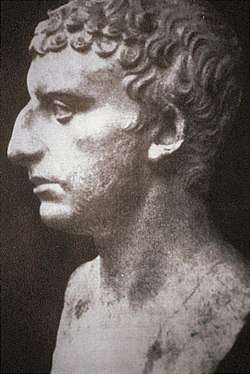
- 2 Timothy 3:8–9. Rome, 67 CE. (magicians opposing Moses).
- Revelation 16:12–16 (frogs); 17:17 (changing hearts to God's purpose). Late 1st century CE.
- Josephus. The Wars of the Jews, 5:9:4. Circa 75 CE. Reprinted in, e.g., The Works of Josephus: Complete and Unabridged, New Updated Edition. Translated by William Whiston, page 716. Peabody, Massachusetts: Hendrickson Publishers, 1987. ISBN 0-913573-86-8.
- Josephus. Antiquities of the Jews 2:13:3–2:14:4. Circa 93–94. Reprinted in, e.g., The Works of Josephus: Complete and Unabridged, New Updated Edition. Translated by William Whiston, pages 72–74. Peabody, Massachusetts: Hendrickson Publishers, 1987. ISBN 0-913573-86-8.
.jpg)
Classical rabbinic
- Mishnah: Orlah 1:1–3:9; Pesachim 10:1; Shevuot 5:3; Yadayim 4:8. Land of Israel, circa 200 CE. Reprinted in, e.g., The Mishnah: A New Translation. Translated by Jacob Neusner, pages 158–66, 249, 630, 1131. New Haven: Yale University Press, 1988. ISBN 0-300-05022-4.
- Tosefta: Megillah 3:21; Sotah 4:12; Keritot 4:15. Land of Israel, circa 300 CE. Reprinted in, e.g., The Tosefta: Translated from the Hebrew, with a New Introduction. Translated by Jacob Neusner, 649, 848, 1571. Peabody, Massachusetts: Hendrickson Publishers, 2002. ISBN 1-56563-642-2.
- Jerusalem Talmud: Pesachim 42b; Rosh Hashanah 20b; Megillah 13b; Chagigah 4a, 11a; Yevamot 63a; Sotah 10a, 28b; Sanhedrin 26b. Land of Israel, circa 400 CE. Reprinted in, e.g., Talmud Yerushalmi. Edited by Chaim Malinowitz, Yisroel Simcha Schorr, and Mordechai Marcus, volumes 18, 24, 26–27, 30, 36. Brooklyn: Mesorah Publications, 2011–2017. And reprinted in, e.g., The Jerusalem Talmud: A Translation and Commentary. Edited by Jacob Neusner and translated by Jacob Neusner, Tzvee Zahavy, B. Barry Levy, and Edward Goldman. Peabody, Massachusetts: Hendrickson Publishers, 2009. ISBN 978-1-59856-528-7.
- Genesis Rabbah 1:15; 5:7; 18:5; 19:7; 37:3; 46:1, 5; 82:3; 88:5; 92:7; 96, 97. Land of Israel, 5th century. Reprinted in, e.g., Midrash Rabbah: Genesis. Translated by Harry Freedman and Maurice Simon, volume 1, pages 14, 37–38, 144, 153, 296, 389, 392; volume 2, pages 754, 816, 853, 898, 929. London: Soncino Press, 1939. ISBN 0-900689-38-2.
- Mekhilta of Rabbi Ishmael Beshallah 7. Land of Israel, late 4th century. Reprinted in, e.g., Mekhilta According to Rabbi Ishmael. Translated by Jacob Neusner, volume 1, pages 169–70. Atlanta: Scholars Press, 1988. ISBN 1-55540-237-2. And Mekhilta de-Rabbi Ishmael. Translated by Jacob Z. Lauterbach, volume 1, page 166. Philadelphia: Jewish Publication Society, 1933, reissued 2004. ISBN 0-8276-0678-8.
.jpg)
- Mekhilta of Rabbi Simeon 2:1–2, 5; 3:1; 15:4–5; 16:1, 4; 19:4; 21:4; 22:6; 26:3, 6; 35:1; 47:2. Land of Israel, 5th century. Reprinted in, e.g., Mekhilta de-Rabbi Shimon bar Yohai. Translated by W. David Nelson, pages 5–7, 9–11, 50–51, 54, 56, 78–79, 89, 93, 114, 117, 150, 209. Philadelphia: Jewish Publication Society, 2006. ISBN 0-8276-0799-7.
- Babylonian Talmud: Berakhot 38a, 54b; Eruvin 83b; Pesachim 53b, 99b; Rosh Hashanah 11b; Megillah 11a; Moed Katan 6a, 18a; Chagigah 13b; Nedarim 51b; Sotah 11b, 43a; Bava Kamma 80b; Bava Batra 91a, 109b–10a, 116a, 117b; Sanhedrin 12a, 58b, 67b, 82b, 90b, 111a; Shevuot 35b; Menachot 68b, 84a; Chullin 134a; Bekhorot 41a. Babylonia, 6th century. Reprinted in, e.g., Talmud Bavli. Edited by Yisroel Simcha Schorr, Chaim Malinowitz, and Mordechai Marcus, 72 volumes. Brooklyn: Mesorah Pubs., 2006.
Medieval
- Saadia Gaon. Emunoth ve-Deoth (Beliefs and Opinions). Baghdad, Babylonia, 933. Reprinted in, e.g., The Book of Beliefs and Opinions. Translated by Samuel Rosenblatt, pages 29, 116–17, 152, 154, 199, 411. New Haven: Yale University Press, 1948. ISBN 0-300-04490-9.
- Exodus Rabbah 5:14, 6:1–12:7, 23:9, 25:27, 28:4. 10th century. Reprinted in, e.g., Midrash Rabbah: Exodus. Translated by Simon M. Lehrman, volume 3. London: Soncino Press, 1939. ISBN 0-900689-38-2.
- Rashi. Commentary. Exodus 6–9. Troyes, France, late 11th century. Reprinted in, e.g., Rashi. The Torah: With Rashi's Commentary Translated, Annotated, and Elucidated. Translated and annotated by Yisrael Isser Zvi Herczeg, volume 2, pages 53–90. Brooklyn: Mesorah Publications, 1994. ISBN 0-89906-027-7.
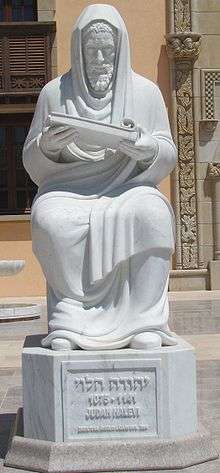
- Rashbam. Commentary on the Torah. Troyes, early 12th century. Reprinted in, e.g., Rashbam's Commentary on Exodus: An Annotated Translation. Edited and translated by Martin I. Lockshin, pages 59–92. Atlanta: Scholars Press, 1997. ISBN 0-7885-0225-5.
- Judah Halevi. Kuzari. 1:25; 2:2. Toledo, Spain, 1130–1140. Reprinted in, e.g., Jehuda Halevi. Kuzari: An Argument for the Faith of Israel. Introduction by Henry Slonimsky, pages 46, 86. New York: Schocken, 1964. ISBN 0-8052-0075-4.
- Abraham ibn Ezra. Commentary on the Torah. France, 1153. Reprinted in, e.g., Ibn Ezra's Commentary on the Pentateuch: Exodus (Shemot). Translated and annotated by H. Norman Strickman and Arthur M. Silver, volume 2, pages 129–82. New York: Menorah Publishing Company, 1996. ISBN 0-932232-08-6.
- Maimonides. Mishneh Torah: Hilchot Teshuvah (The Laws of Repentance), chapter 3, halachah 3. Egypt. Circa 1170–1180. Reprinted in, e.g., Mishneh Torah: Hilchot Teshuvah: The Laws of Repentance. Translated by Eliyahu Touger, pages 140–48. New York: Moznaim Publishing, 1990. OCLC 28239393 ISBN 978-0-940118-20-1.

- Maimonides. Mishneh Torah: Hilchot Chometz U'Matzah (The Laws of Chametz and Matzah), chapter 7, halachah 7. Egypt, circa 1170–1180. Reprinted in, e.g., Mishneh Torah: Hilchot Chametz U'Matzah: The Laws of Chametz and Matzah: The Rambam's Text of the Haggadah. Translated by Eliyahu Touger. New York: Moznaim Publishing, 1988.
- Maimonides. The Eight Chapters on Ethics, chapter 8. Egypt. Late 12th century. Reprinted in, e.g., The Eight Chapters of Maimonides on Ethics (Shemonah Perakim): A Psychological and Ethical Treatise. Edited, annotated, and translated, with an introduction by Joseph I. Gorfinkle, pages 95–96. New York: Columbia University Press, 1912. Reprinted by Forgotten Books, 2012.
- Maimonides. The Guide for the Perplexed, part 1, chapters 24, 45– 46; part 2, chapter 35; part 3, chapters 29, 46, 54. Cairo, Egypt, 1190. Reprinted in, e.g., Moses Maimonides. The Guide for the Perplexed. Translated by Michael Friedländer, pages 33, 58, 61, 224, 318, 359, 397. New York: Dover Publications, 1956. ISBN 0-486-20351-4.
- Jacob Anatoli. "Sermon on Wa-'Era: A Homily on Education." First half of 13th century. In Marc Saperstein. Jewish Preaching, 1200–1800: An Anthology, pages 113–23. New Haven: Yale University Press, 1989. ISBN 0-300-04355-4.
- Hezekiah ben Manoah. Hizkuni. France, circa 1240. Reprinted in, e.g., Chizkiyahu ben Manoach. Chizkuni: Torah Commentary. Translated and annotated by Eliyahu Munk, volume 2, pages 382–99. Jerusalem: Ktav Publishers, 2013. ISBN 978-1-60280-261-2.
- Nachmanides. Commentary on the Torah. Jerusalem, circa 1270. Reprinted in, e.g., Ramban (Nachmanides): Commentary on the Torah. Translated by Charles B. Chavel, volume 2, pages 63–99. New York: Shilo Publishing House, 1973. ISBN 0-88328-007-8.
- Zohar 2:22a–32a. Spain, late 13th century. Reprinted in, e.g., The Zohar. Translated by Harry Sperling and Maurice Simon. 5 volumes. London: Soncino Press, 1934.
- Bahya ben Asher. Commentary on the Torah. Spain, early 14th century. Reprinted in, e.g., Midrash Rabbeinu Bachya: Torah Commentary by Rabbi Bachya ben Asher. Translated and annotated by Eliyahu Munk, volume 3, pages 815–54. Jerusalem: Lambda Publishers, 2003. ISBN 965-7108-45-4.
- Jacob ben Asher (Baal Ha-Turim). Commentary on the Torah. Early 14th century. Reprinted in, e.g., Baal Haturim Chumash: Shemos/Exodus. Translated by Eliyahu Touger; edited and annotated by Avie Gold, volume 2, pages 569–607. Brooklyn: Mesorah Publications, 2000. ISBN 1-57819-129-7.
- Isaac ben Moses Arama. Akedat Yizhak (The Binding of Isaac). Late 15th century. Reprinted in, e.g., Yitzchak Arama. Akeydat Yitzchak: Commentary of Rabbi Yitzchak Arama on the Torah. Translated and condensed by Eliyahu Munk, volume 1, pages 331–45. New York, Lambda Publishers, 2001. ISBN 965-7108-30-6.
Modern
- Isaac Abravanel. Commentary on the Torah. Italy, between 1492–1509. Reprinted in, e.g., Abarbanel: Selected Commentaries on the Torah: Volume 2: Shemos/Exodus. Translated and annotated by Israel Lazar, pages 85–133. Brooklyn: CreateSpace, 2015. ISBN 978-1508640219.
- Abraham Saba. Ẓeror ha-Mor (Bundle of Myrrh). Fez, Morocco, circa 1500. Reprinted in, e.g., Tzror Hamor: Torah Commentary by Rabbi Avraham Sabba. Translated and annotated by Eliyahu Munk, volume 3, pages 895–920. Jerusalem, Lambda Publishers, 2008. ISBN 978-965-524-013-9.
- Obadiah ben Jacob Sforno. Commentary on the Torah. Venice, 1567. Reprinted in, e.g., Sforno: Commentary on the Torah. Translation and explanatory notes by Raphael Pelcovitz, pages 308–27. Brooklyn: Mesorah Publications, 1997. ISBN 0-89906-268-7.
- Moshe Alshich. Commentary on the Torah. Safed, circa 1593. Reprinted in, e.g., Moshe Alshich. Midrash of Rabbi Moshe Alshich on the Torah. Translated and annotated by Eliyahu Munk, volume 2, pages 375–400. New York, Lambda Publishers, 2000. ISBN 965-7108-13-6.
- Shlomo Ephraim Luntschitz. Kli Yakar. Lublin, 1602. Reprinted in, e.g., Kli Yakar: Shemos. Translated by Elihu Levine, volume 1, pages 80–130. Southfield, Michigan: Targum Press/Feldheim Publishers, 2002. ISBN 1-56871-202-2.
.jpg)
- Avraham Yehoshua Heschel. Commentaries on the Torah. Cracow, Poland, mid 17th century. Compiled as Chanukat HaTorah. Edited by Chanoch Henoch Erzohn. Piotrkow, Poland, 1900. Reprinted in Avraham Yehoshua Heschel. Chanukas HaTorah: Mystical Insights of Rav Avraham Yehoshua Heschel on Chumash. Translated by Avraham Peretz Friedman, pages 125–31. Southfield, Michigan: Targum Press/Feldheim Publishers, 2004. ISBN 1-56871-303-7.
- Thomas Hobbes. Leviathan, 3:36, 37. England, 1651. Reprint edited by C. B. Macpherson, pages 456, 474. Harmondsworth, England: Penguin Classics, 1982. ISBN 0-14-043195-0.
- Chaim ibn Attar. Ohr ha-Chaim. Venice, 1742. Reprinted in Chayim ben Attar. Or Hachayim: Commentary on the Torah. Translated by Eliyahu Munk, volume 2, pages 499–533. Brooklyn: Lambda Publishers, 1999. ISBN 965-7108-12-8.
- Nachman of Breslov. Teachings. Bratslav, Ukraine, before 1811. Reprinted in Rebbe Nachman's Torah: Breslov Insights into the Weekly Torah Reading: Exodus-Leviticus. Compiled by Chaim Kramer; edited by Y. Hall, pages 56–63. Jerusalem: Breslov Research Institute, 2011. ISBN 978-1-928822-53-0.
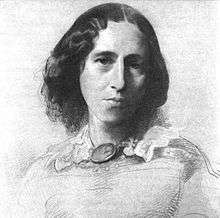
- George Eliot. Adam Bede, chapter 32. Edinburgh and London: William Blackwood and Sons, 1859. Reprinted, e.g., edited by Carol A. Martin, page 313. Oxford: Oxford University Press, 2008. (when the Squire threatens to replace the Poysers with a new tenant, Mr. Thurle, Mrs. Poyser tells the Squire, “I say, if Mr Thurle’s so ready to take farms under you, it’s a pity but what he should take this, and see if he likes to live in a house wi’ all the plagues o’ Egypt in’t — wi’ the cellar full o’ water, and frogs and toads hoppin’ up the steps by dozens.”).
.crop.jpg)
- Samson Raphael Hirsch. The Pentateuch: Exodus. Translated by Isaac Levy, volume 2, pages 63–106. Gateshead: Judaica Press, 2nd edition 1999. ISBN 0-910818-12-6. Originally published as Der Pentateuch uebersetzt und erklaert. Frankfurt, 1867–1878.
- Samuel David Luzzatto (Shadal). Commentary on the Torah. Padua, 1871. Reprinted in, e.g., Samuel David Luzzatto. Torah Commentary. Translated and annotated by Eliyahu Munk, volume 2, pages 561–93. New York: Lambda Publishers, 2012. ISBN 978-965-524-067-2.
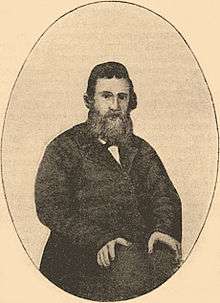
- Malbim. The Torah and the Commandments. Warsaw, 1874–80. Reprinted in, e.g., Malbim: Rabbenu Meir Leibush ben Yechiel Michel. Commentary on the Torah. Translated by Zvi Faier, volume 4, pages 158–252. Israel: M.P. Press/Hillel Press, 1984. OCLC 187452464 (1982).
- Yehudah Aryeh Leib Alter. Sefat Emet. Góra Kalwaria (Ger), Poland, before 1906. Excerpted in The Language of Truth: The Torah Commentary of Sefat Emet. Translated and interpreted by Arthur Green, pages 87–91. Philadelphia: Jewish Publication Society, 1998. ISBN 0-8276-0650-8. Reprinted 2012. ISBN 0-8276-0946-9.
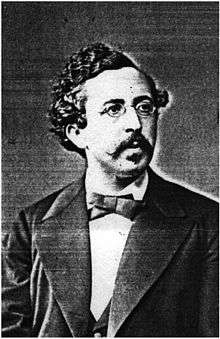
- Hermann Cohen. Religion of Reason: Out of the Sources of Judaism. Translated with an introduction by Simon Kaplan; introductory essays by Leo Strauss, page 39. New York: Ungar, 1972. Reprinted Atlanta: Scholars Press, 1995. ISBN 0-7885-0102-X. Originally published as Religion der Vernunft aus den Quellen des Judentums. Leipzig: Gustav Fock, 1919.
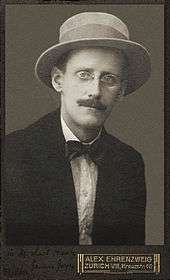
- James Joyce. Ulysses, chapter 7 (Aeolus). Paris: Shakespeare and Company, 1922. Reprinted, e.g., Ulysses: The Corrected Text. Edited by Hans Walter Gabler with Wolfhard Steppe and Claus Melchior, pages 116–17. New York: Random House, 1986. ISBN 0-394-55373-X. (The orator John F. Taylor is quoted saying: “It seemed to me that I had been transported into a country far away from this country, into an age remote from this age, that I stood in ancient Egypt and that I was listening to the speech of some highpriest of that land addressed to the youthful Moses. . . . And it seemed to me that I heard the voice of that Egyptian highpriest raised in a tone of like haughtiness and like pride. I heard his words and their meaning was revealed to me. . . . Why will you Jews not accept our culture, our religion and our language? You are a tribe of nomad herdsmen: we are a mighty people. You have no cities nor no wealth: our cities are hives of humanity and our galleys, trireme and quadrireme, laden with all manner merchandise furrow the waters of the known globe. You have but emerged from primitive conditions: we have a literature, a priesthood, an agelong history and a polity. . . . But, ladies and gentlemen, had the youthful Moses listened to and accepted that view of life, had he bowed his head and bowed his will and bowed his spirit before that arrogant admonition he would never have brought the chosen people out of their house of bondage, nor followed the pillar of the cloud by day. He would never have spoken with the Eternal amid lightnings on Sinai's mountaintop nor ever have come down with the light of inspiration shining in his countenance and bearing in his arms the tables of the law, graven in the language of the outlaw.”).
- Alexander Alan Steinbach. Sabbath Queen: Fifty-four Bible Talks to the Young Based on Each Portion of the Pentateuch, pages 42–45. New York: Behrman's Jewish Book House, 1936.
- Benno Jacob. The Second Book of the Bible: Exodus. London, 1940. Translated by Walter Jacob, pages 142–280. Hoboken, New Jersey: KTAV Publishing House, 1992. ISBN 0-88125-028-7.
- Thomas Mann. Joseph and His Brothers. Translated by John E. Woods, page 788. New York: Alfred A. Knopf, 2005. ISBN 1-4000-4001-9. Originally published as Joseph und seine Brüder. Stockholm: Bermann-Fischer Verlag, 1943.
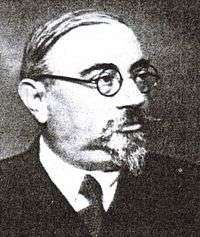
- Umberto Cassuto. A Commentary on the Book of Exodus. Jerusalem, 1951. Translated by Israel Abrahams, pages 76–122. Jerusalem: The Magnes Press, The Hebrew University, 1967.
- Elie Munk. The Call of the Torah: An Anthology of Interpretation and Commentary on the Five Books of Moses. Translated by E.S. Mazer, volume 2, pages 74–111. Brooklyn: Mesorah Publications, 1995. ISBN 0-89906-042-0. Originally published as La Voix de la Thora. Paris: Fondation Samuel et Odette Levy, 1981.
- Walther Zimmerli. "I Am Yahweh." In I Am Yahweh. Translated by Douglas W. Stott; edited and introduction by Walter Brueggemann, pages 1–28. Atlanta: John Knox Press, 1982. ISBN 0-8042-0519-1. Originally published in Geschichte und Altes Testament, pages 179–209. J.C.B. Mohr, 1953.
- Roland de Vaux. "The Revelation of the Divine Name YHVH." In Proclamation and Presence: Old Testament Essays in Honour of Gwynne Henton Davies. Edited by John I. Durham and J. Roy Porter, pages 48–75. London: SCM Press, 1970. ISBN 0-334-01319-4.
- Marvin H. Pope. “Mid Rock and Scrub, A Ugaritic Parallel to Exodus 7:19.” In Biblical and Near Eastern Studies: Essays in Honor of William Sanford La Sor. Edited by Gary A. Tuttle, pages 146–50. Grand Rapids, Michigan: Eerdmans, 1978. ISBN 0-8028-3500-7.
- Robert R. Wilson, "The Hardening of Pharaoh's Heart." Catholic Biblical Quarterly, volume 41 (number 1) (1979): pages 18–36.
- Ziony Zevit. "Three Ways to Look at the Ten Plagues: Were They Natural Disasters, A Demonstration of the Impotence of the Egyptian Gods or an Undoing of Creation?" Bible Review, volume 6 (number 3) (June 1980).
- John E. Currid. "Why Did God Harden Pharaoh's Heart?" Bible Review, volume 9 (number 6) (November/December 1983).
- Judith R. Baskin. Pharaoh's Counsellors: Job, Jethro, and Balaam in Rabbinic and Patristic Tradition. Brown Judaic Studies, 1983. ISBN 0891306374.
- Pinchas H. Peli. Torah Today: A Renewed Encounter with Scripture, pages 59–62. Washington, D.C.: B'nai B'rith Books, 1987. ISBN 0-910250-12-X.
- Mark S. Smith. The Early History of God: Yahweh and the Other Deities in Ancient Israel, pages 4, 8, 66. New York: HarperSanFrancisco, 1990. ISBN 0-06-067416-4.
- Harvey J. Fields. A Torah Commentary for Our Times: Volume II: Exodus and Leviticus, pages 17–24. New York: UAHC Press, 1991. ISBN 0-8074-0334-2.
- Nahum M. Sarna. The JPS Torah Commentary: Exodus: The Traditional Hebrew Text with the New JPS Translation, pages 30–48, 269. Philadelphia: Jewish Publication Society, 1991. ISBN 0-8276-0327-4.
- Nehama Leibowitz. New Studies in Shemot (Exodus), pages 114–77. Jerusalem: Haomanim Press, 1993. Reprinted as New Studies in the Weekly Parasha. Lambda Publishers, 2010. ISBN 965524038X.
- Aaron Wildavsky. Assimilation versus Separation: Joseph the Administrator and the Politics of Religion in Biblical Israel, page 14. New Brunswick, N.J.: Transaction Publishers, 1993. ISBN 1-56000-081-3.
- Walter Brueggemann. “The Book of Exodus.” In The New Interpreter's Bible. Edited by Leander E. Keck, volume 1, pages 731–60. Nashville: Abingdon Press, 1994. ISBN 0-687-27814-7.
- Judith S. Antonelli. "Elisheva." In In the Image of God: A Feminist Commentary on the Torah, pages 146–53. Northvale, New Jersey: Jason Aronson, 1995. ISBN 1-56821-438-3.
- Ellen Frankel. The Five Books of Miriam: A Woman’s Commentary on the Torah, pages 102–04. New York: G. P. Putnam's Sons, 1996. ISBN 0-399-14195-2.
- Marc Gellman. "The Pharaoh and the Frog." In God's Mailbox: More Stories About Stories in the Bible, pages 36–43. New York: Morrow Junior Books, 1996. ISBN 0-688-13169-7.
- W. Gunther Plaut. The Haftarah Commentary, pages 131–39. New York: UAHC Press, 1996. ISBN 0-8074-0551-5.
- Sorel Goldberg Loeb and Barbara Binder Kadden. Teaching Torah: A Treasury of Insights and Activities, pages 94–99. Denver: A.R.E. Publishing, 1997. ISBN 0-86705-041-1.
- William H.C. Propp. Exodus 1–18, volume 2, pages 261–354. New York: Anchor Bible, 1998. ISBN 0-385-14804-6.
- Susan Freeman. Teaching Jewish Virtues: Sacred Sources and Arts Activities, pages 332–46. Springfield, New Jersey: A.R.E. Publishing, 1999. ISBN 978-0-86705-045-5. (Exodus 9:30).
- Exodus to Deuteronomy: A Feminist Companion to the Bible (Second Series). Edited by Athalya Brenner, pages 22, 30–31, 47, 59, 85, 95–96, 98, 100–01, 107, 164, 169. Sheffield: Sheffield Academic Press, 2000. ISBN 1-84127-079-2.
- Avivah Gottlieb Zornberg. The Particulars of Rapture: Reflections on Exodus, pages 81–131. New York: Doubleday, 2001. ISBN 0-385-49152-2.
- Lainie Blum Cogan and Judy Weiss. Teaching Haftarah: Background, Insights, and Strategies, pages 451–57. Denver: A.R.E. Publishing, 2002. ISBN 0-86705-054-3.
- Michael Fishbane. The JPS Bible Commentary: Haftarot, pages 87–93. Philadelphia: Jewish Publication Society, 2002. ISBN 0-8276-0691-5.
- Bernhard Lang. "Why God Has So Many Names." Bible Review, volume 19 (number 4) (August 2003): pages 48–54, 63.

- Robert Alter. The Five Books of Moses: A Translation with Commentary, pages 339–64. New York: W.W. Norton & Co., 2004. ISBN 0-393-01955-1.
- Barack Obama. Dreams from My Father, page 294. New York: Three Rivers Press, 1995, 2004. ISBN 1-4000-8277-3. (Moses and Pharaoh).
- Jeffrey H. Tigay. "What's in a Name? Early Evidence of Devotion Exclusively to Yahweh." Bible Review, volume 20 (number 1) (February 2004): pages 34–43, 47–51.
- Jeffrey H. Tigay. "Exodus." In The Jewish Study Bible. Edited by Adele Berlin and Marc Zvi Brettler, pages 115–22. New York: Oxford University Press, 2004. ISBN 0-19-529751-2.
_by_Erling_Mandelmann.jpg)
- Marek Halter. Zipporah, Wife of Moses, pages 245–49. New York: Crown, 2005. ISBN 1-4000-5279-3.
- Professors on the Parashah: Studies on the Weekly Torah Reading Edited by Leib Moscovitz, pages 94–99. Jerusalem: Urim Publications, 2005. ISBN 965-7108-74-8.
- Lawrence Kushner. Kabbalah: A Love Story, page 78. New York: Morgan Road Books, 2006. ISBN 0-7679-2412-6.
- W. Gunther Plaut. The Torah: A Modern Commentary: Revised Edition. Revised edition edited by David E.S. Stern, pages 379–404. New York: Union for Reform Judaism, 2006. ISBN 0-8074-0883-2.
- Suzanne A. Brody. "The highest form." In Dancing in the White Spaces: The Yearly Torah Cycle and More Poems, page 76. Shelbyville, Kentucky: Wasteland Press, 2007. ISBN 1-60047-112-9.
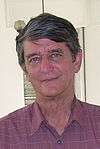
- James L. Kugel. How To Read the Bible: A Guide to Scripture, Then and Now, pages 40, 54, 205, 216–32, 376, 421, 425. New York: Free Press, 2007. ISBN 0-7432-3586-X.
- The Torah: A Women's Commentary. Edited by Tamara Cohn Eskenazi and Andrea L. Weiss, pages 311–54. New York: URJ Press, 2008. ISBN 0-8074-1081-0.
- Thomas B. Dozeman. Commentary on Exodus, pages 159–238. Grand Rapids, Michigan: William B. Eerdmans Publishing Company, 2009. ISBN 978-0-8028-2617-6.
- Reuven Hammer. Entering Torah: Prefaces to the Weekly Torah Portion, pages 83–88. New York: Gefen Publishing House, 2009. ISBN 978-965-229-434-0.
- Rebecca G.S. Idestrom. “Echoes of the Book of Exodus in Ezekiel.” Journal for the Study of the Old Testament, volume 33 (number 4) (June 2009): pages 489–510. (Motifs from Exodus found in Ezekiel, including the call narrative, divine encounters, captivity, signs, plagues, judgment, redemption, tabernacle/temple, are considered.).
- Jhos Singer. “Uncircumcized Lips: Parashat Vaeira (Exodus 6:2–9:35).” In Torah Queeries: Weekly Commentaries on the Hebrew Bible. Edited by Gregg Drinkwater, Joshua Lesser, and David Shneer; foreword by Judith Plaskow, pages 80–84. New York: New York University Press, 2009. ISBN 0-8147-2012-9.
- Bruce Wells. "Exodus." In Zondervan Illustrated Bible Backgrounds Commentary. Edited by John H. Walton, volume 1, pages 181–98. Grand Rapids, Michigan: Zondervan, 2009. ISBN 978-0-310-25573-4.
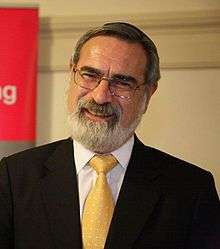
- Berel Dov Lerner. “Crying Out About Frogs.” Vetus Testamentum, volume 60 (number 4) (2010): pages 662–63.
- Jonathan Sacks. Covenant & Conversation: A Weekly Reading of the Jewish Bible: Exodus: The Book of Redemption, pages 41–68. Jerusalem: Maggid Books, 2010. ISBN 159-264-0214.
- Sam Ernst and Jim Dunn. "A Tale of Two Audreys." In Haven, season 2, episode 1. Entertainment One, 2011. (plagues plot element).

- Shmuel Herzfeld. "Building a Noble Community." In Fifty-Four Pick Up: Fifteen-Minute Inspirational Torah Lessons, pages 80–85. Jerusalem: Gefen Publishing House, 2012. ISBN 978-965-229-558-3.
- Torah MiEtzion: New Readings in Tanach: Shemot. Edited by Ezra Bick and Yaakov Beasley, pages 61–107. Jerusalem: Maggid Books, 2012. ISBN 161-329-0071.
- Ari Kahn. “Lessons in Leadership.” The Jerusalem Report, volume 25 (number 21) (January 26, 2015): page 47.
- Jonathan Sacks. Lessons in Leadership: A Weekly Reading of the Jewish Bible, pages 67–71. New Milford, Connecticut: Maggid Books, 2015. ISBN 978-1-59264-432-2.
- David Fohrman. The Exodus You Almost Passed Over. Aleph Beta Press, 2016. ISBN 978-0-997-3476-0-9.
- Jean-Pierre Isbouts. Archaeology of the Bible: The Greatest Discoveries From Genesis to the Roman Era, pages 105–07. Washington, D.C.: National Geographic, 2016. ISBN 978-1-4262-1704-3.
- Jonathan Sacks. Essays on Ethics: A Weekly Reading of the Jewish Bible, pages 85–89. New Milford, Connecticut: Maggid Books, 2016. ISBN 978-1-59264-449-0.
- Shai Held. The Heart of Torah, Volume 1: Essays on the Weekly Torah Portion: Genesis and Exodus, pages 134–43. Philadelphia: Jewish Publication Society, 2017. ISBN 978-0827612716.
- Steven Levy and Sarah Levy. The JPS Rashi Discussion Torah Commentary, pages 44–46. Philadelphia: Jewish Publication Society, 2017. ISBN 978-0827612693.
- Bill Dauster. "Pharaoh’s Administration Offers a Cautionary Tale for Today." Washington Jewish Week. January 11, 2018, page 19.
External links

Texts
Commentaries
- Academy for Jewish Religion, California
- Academy for Jewish Religion, New York
- Aish.com
- Akhlah: The Jewish Children's Learning Network
- Aleph Beta Academy
- American Jewish University — Ziegler School of Rabbinic Studies
- Anshe Emes Synagogue, Los Angeles
- Ari Goldwag
- Ascent of Safed
- Bar-Ilan University
- Chabad.org
- eparsha.com
- G-dcast
- The Israel Koschitzky Virtual Beit Midrash
- Jewish Agency for Israel
- Jewish Theological Seminary
- Mechon Hadar
- Miriam Aflalo
- MyJewishLearning.com
- Ohr Sameach
- Orthodox Union
- OzTorah, Torah from Australia
- Oz Ve Shalom — Netivot Shalom
- Pardes from Jerusalem
- Professor James L. Kugel
- Professor Michael Carasik
- Rabbi Dov Linzer
- Rabbi Fabian Werbin
- Rabbi Jonathan Sacks
- RabbiShimon.com
- Rabbi Shlomo Riskin
- Rabbi Shmuel Herzfeld
- Rabbi Stan Levin
- Reconstructionist Judaism
- Sephardic Institute
- Shiur.com
- 613.org Jewish Torah Audio
- Tanach Study Center
- Teach613.org, Torah Education at Cherry Hill
- TheTorah.com
- Torah from Dixie
- Torah.org
- TorahVort.com
- Union for Reform Judaism
- United Synagogue of Conservative Judaism
- What's Bothering Rashi?
- Yeshivat Chovevei Torah
- Yeshiva University
